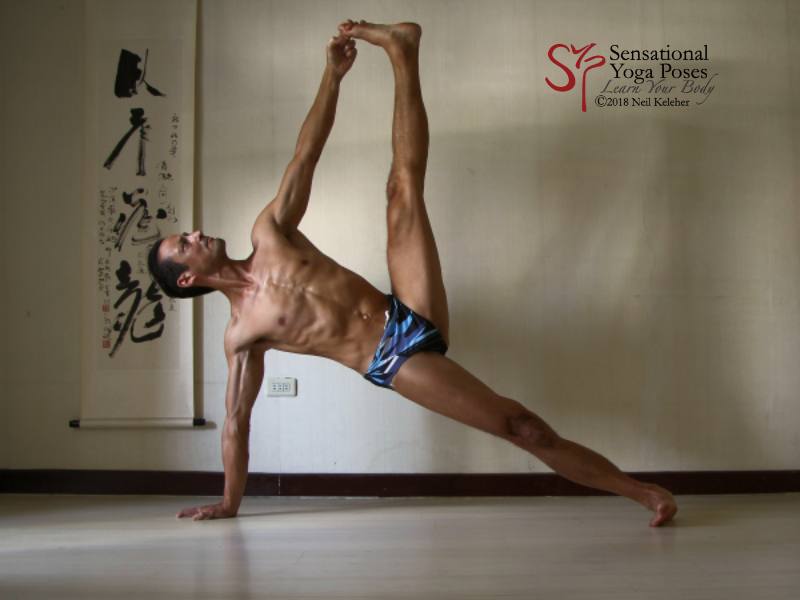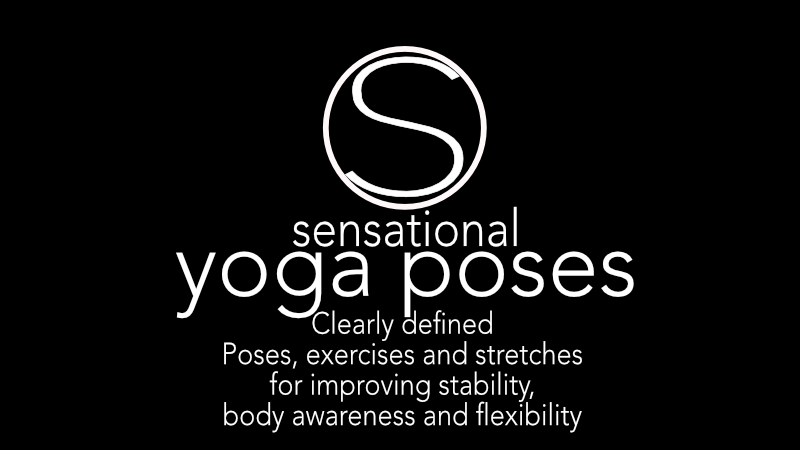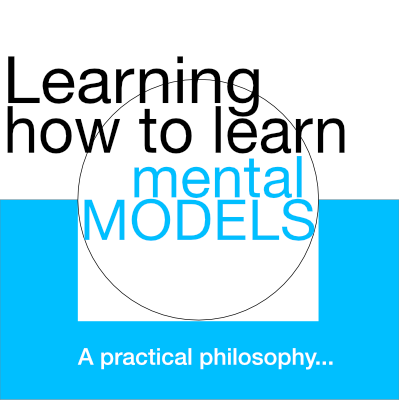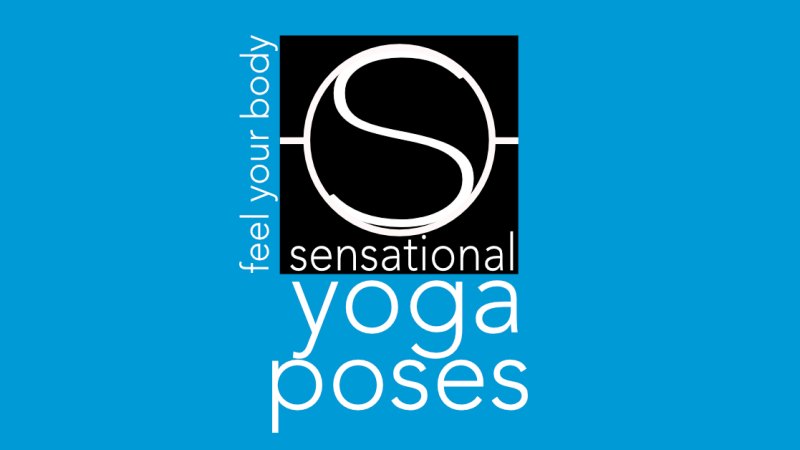Yoga Pose Categories Index
Balancing yoga poses (or balance exercises) can be as simple as balancing on your forefeet or heels.
Another simple way to practice balance is while balancing on one foot. Here too you can try balancing on forefoot or heel.
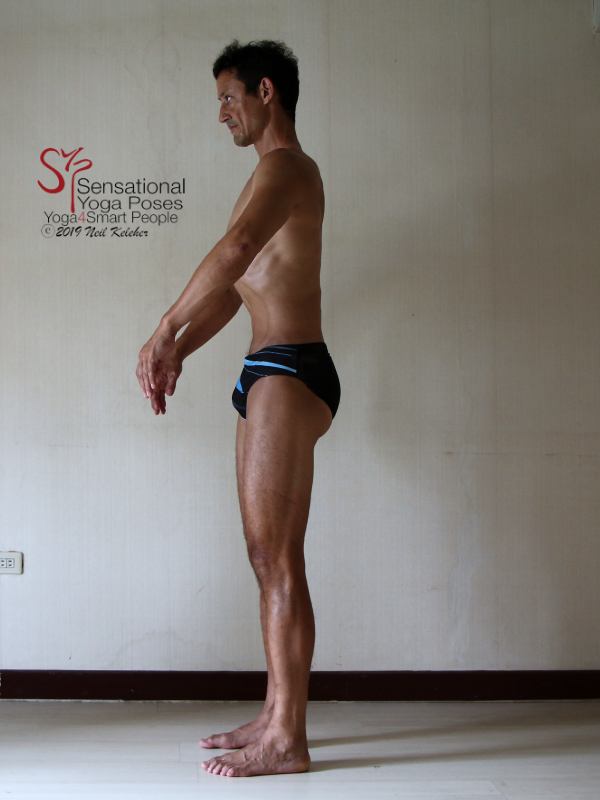
Knee lift prep
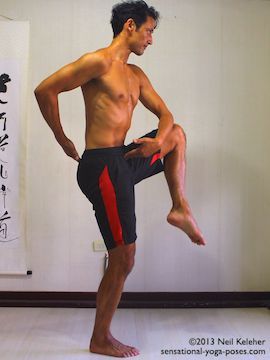
Knee lift
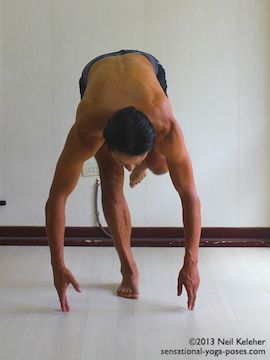
Forward bend on one foot
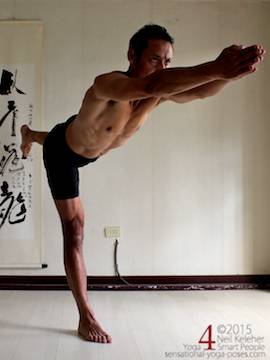
Warrior 3
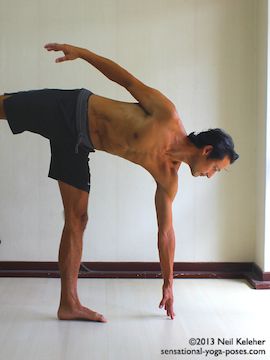
Half moon
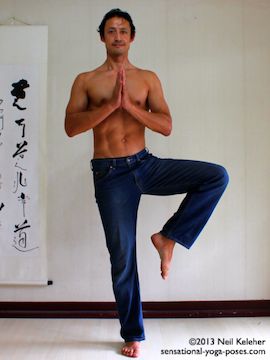
Tree pose modification
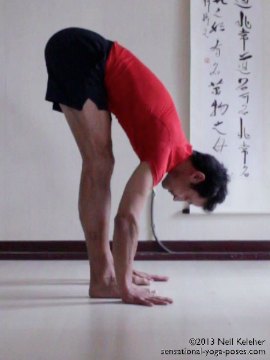
Practicing Leg stability on two feet
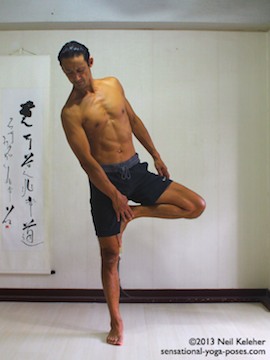
Tree pose
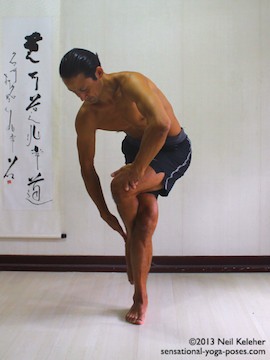
Eagle pose
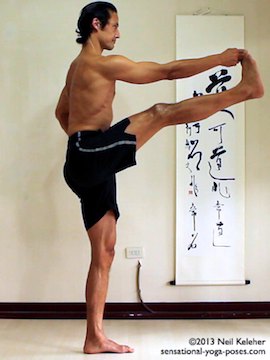
Utthitta hasta padangusthasana
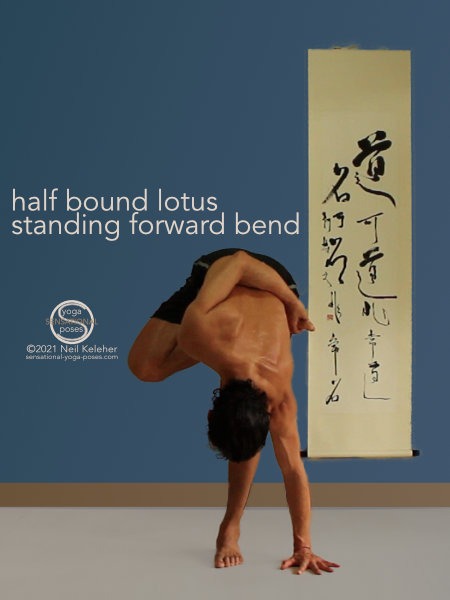
Half bound lotus, standing
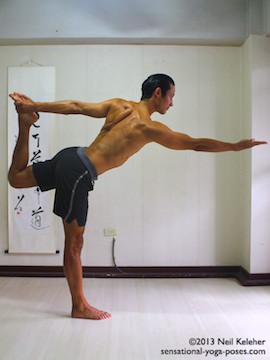
Dancer
Balancing on one shin, you could make balancing easier by pressing your toes into the floor. However, if you balance on the knee with foot lifted, you can move your arms or lifted leg to help stay balanced.
The poses below are from 11 basic balance poses.
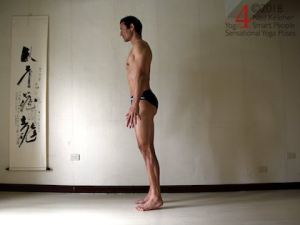
Balance on forefeet
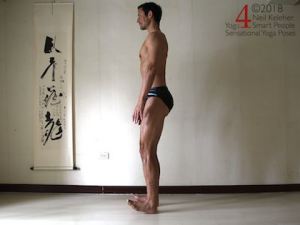
Balance on heels
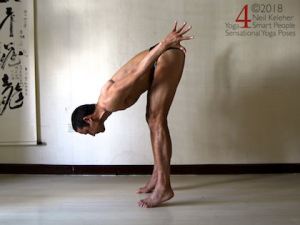
Front bend on forefeet
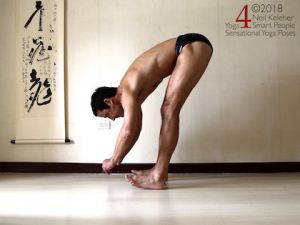
Front bend on heels
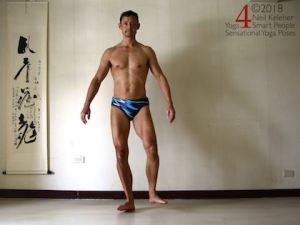
Balancing on one heel
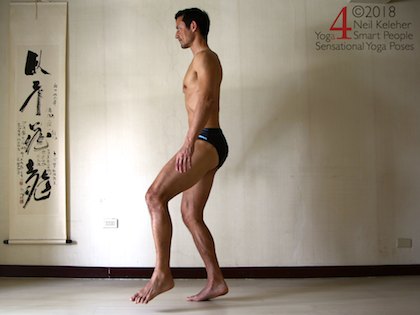
Balancing on one forefoot
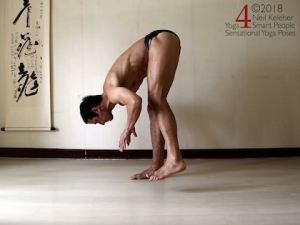
Front bend on one foot
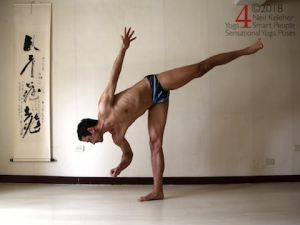
Half moon hand lift
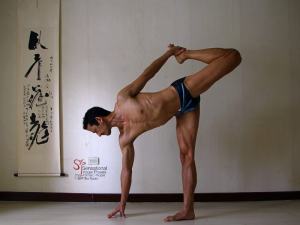
Bow pose on one foot
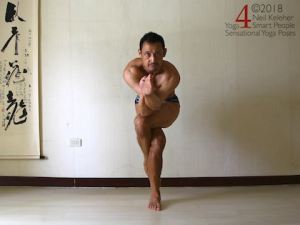
Eagle pose
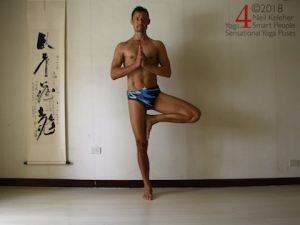
Tree pose

Balancing on one knee
Perhaps the most basic aspect of balance (and this is from a first principles approach) is learning to feel the position of your center of gravity. If you learn how to feel your center, and control it, you can use the same basic idea in any balancing yoga pose. Read how to do that in Feeling Your Center of Gravity.
For a more comprehensive look at balancing yoga poses, take a look at
Yoga poses to improve balance.
If you have limited flexibility, or need an easier way to do yoga poses, one special category of yoga poses is yoga poses using a wall.
Inverted yoga poses are yoga poses where you turn your body upside down. This can include standing on your head in some version of headstand such as this bound headstand yoga pose, balancing in handstand on your hands, balancing on your forearms in forearm stand (aka pincha mayurasana) or even on the back of your head and shoulders in shoulder stand (aka salamba sarvangasana) or plough pose.
To get used to giving your body the support it needs you can use a wall to begin with. Once you are used to being upside down in these poses while supported, then work towards balancing in them.
The general tip for balancing is to feel and control your foundation, and use it to feel and control your center of gravity. Read more on that in feeling your center of gravity.
Side bending yoga poses are a simple way to mobilize the spine (and to a certain extent, the hips).
When doing yoga poses with a side bending element, you can focus on the long side of the side bend or the short side of the side bend. For side bending with a focus on the spine, check out the Side bending the spine article. It includes the poses shown below.
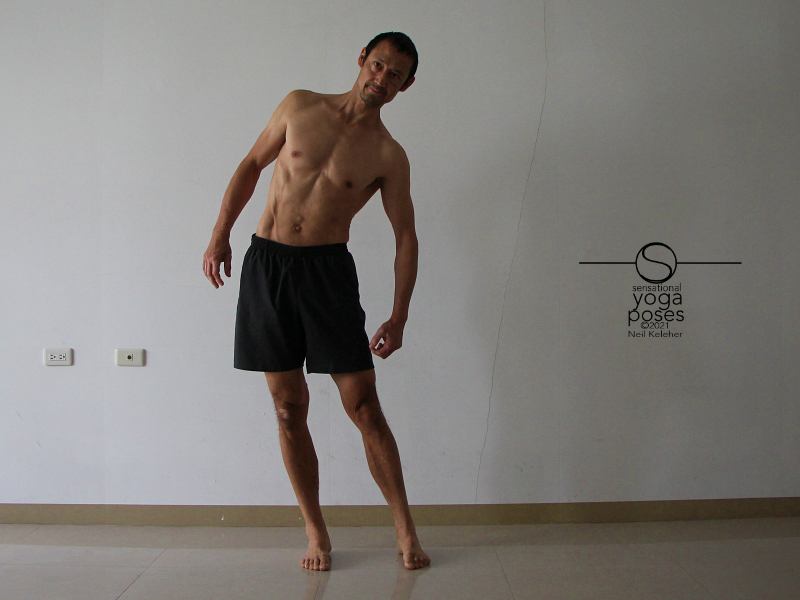
Standing side bend
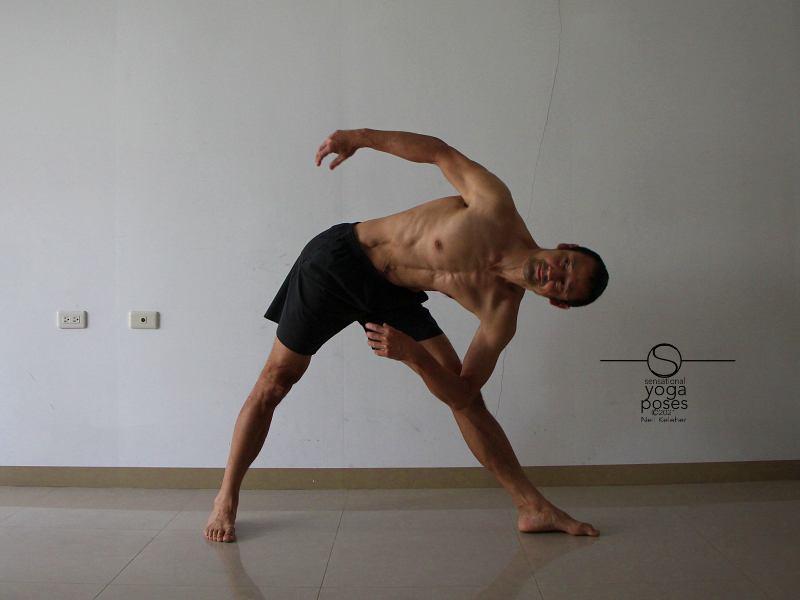
Triangle pose side bend
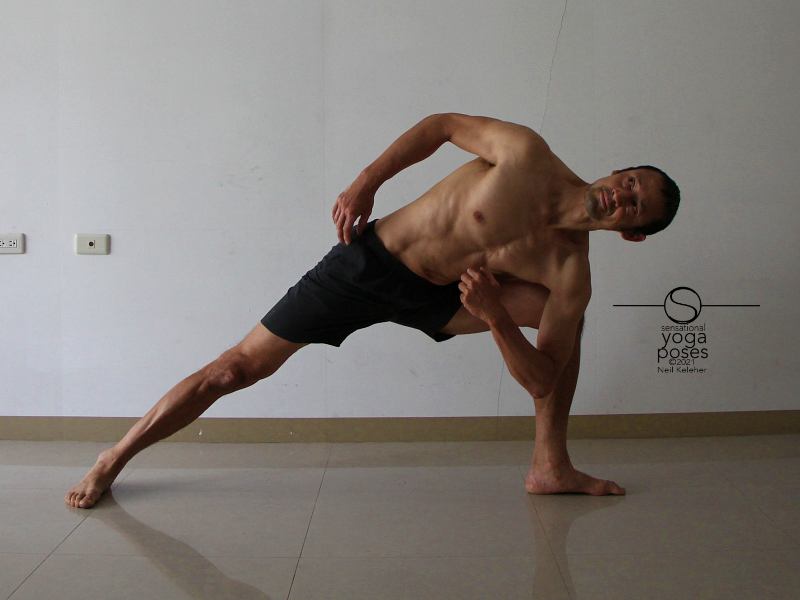
Side angle pose side bend
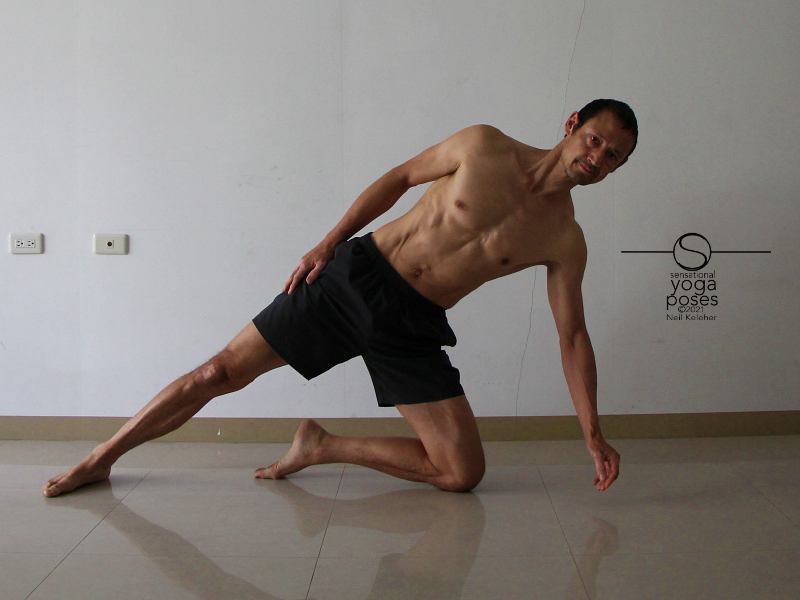
Lateral knee balance
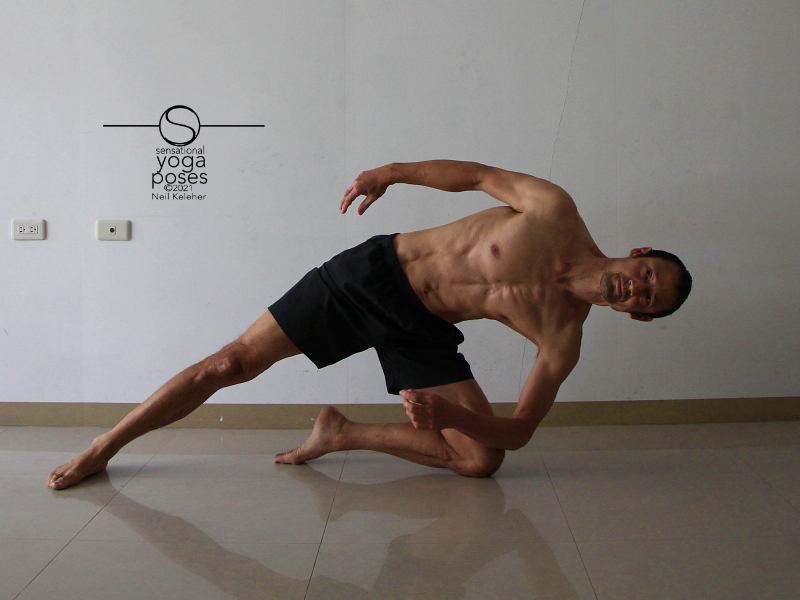
Lateral knee balance side bend
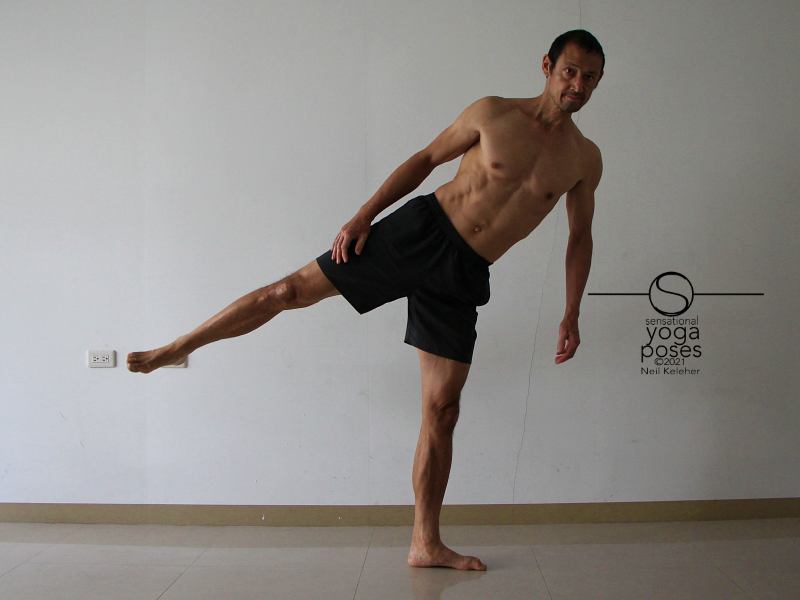
Side balance
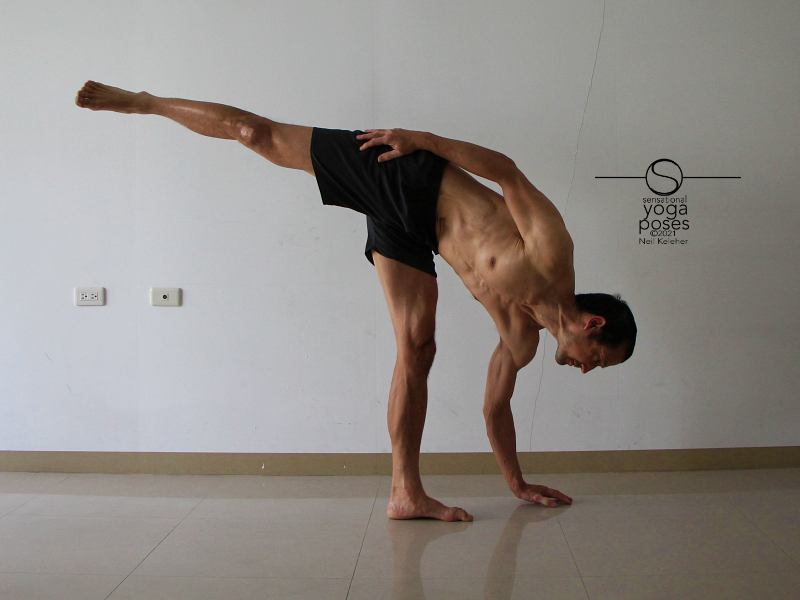
Half moon
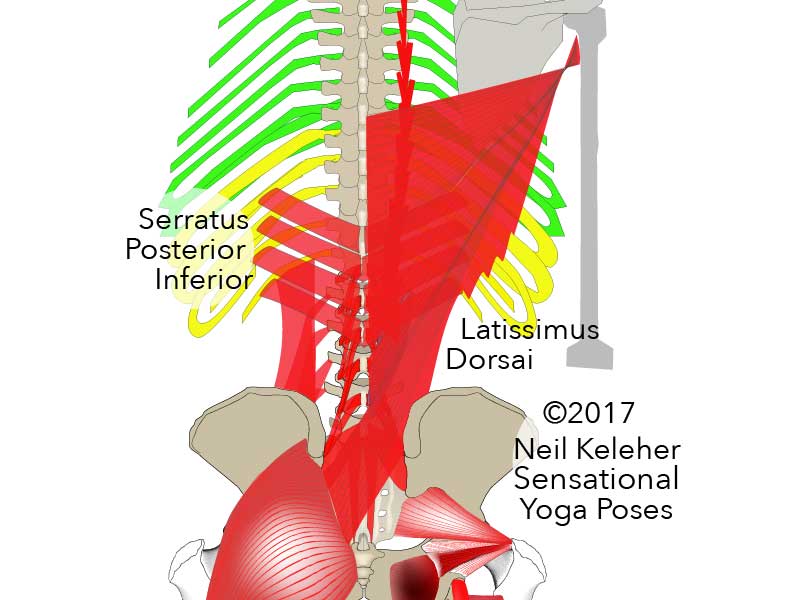
Serratus posterior inferior
Yoga poses with a twisting element can be used to mobilize (and strengthen) the spine as well as the hips.
Currently, one of my favorite spinal twists is the Standing Spinal Twist with Basic Hip Activation.
In almost any non-binding twisting pose, if you focus on twisting the spine while keeping the hips stable, you have a potential ab strengthening exercise on your hands. So while you can use your arms to help you twist when doing Twisting Poses another method is to use the muscles of the torso to twist the elements of the spine relative to each other. In this case you can think of the hip bones, the ribs and even the skull as bony levers that can be worked on by the abs, intercostals and even the spinal erectors.
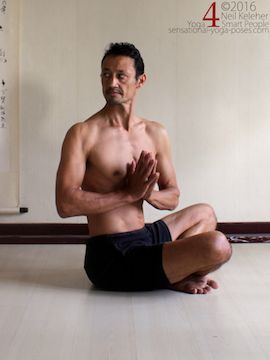
Active seated twist
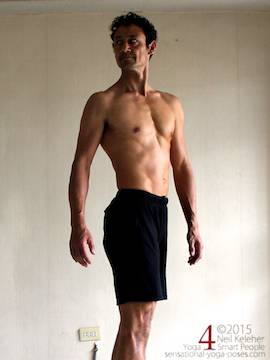
Active standing twist
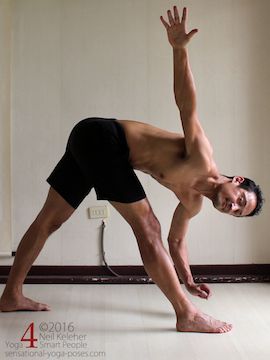
Active Twisting triangle
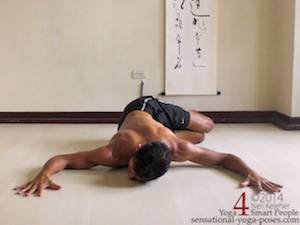
Prone passive twist
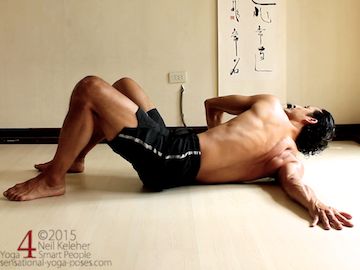
Prone shoulder stretch passive twist

Arm assisted seated twist
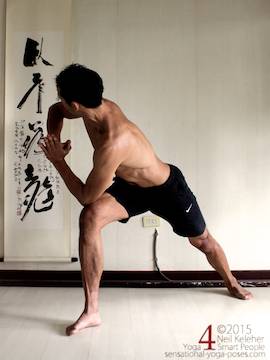
Revolving side angle prayer twist
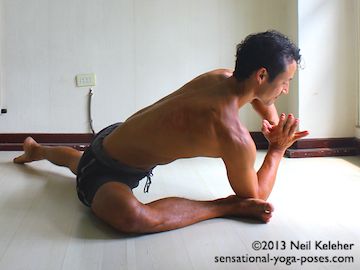
Intense pigeon prayer twist
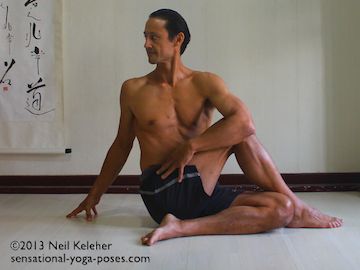
Ardha matsyendrasana
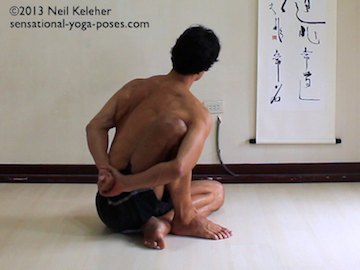
Marichyasana B (variation)
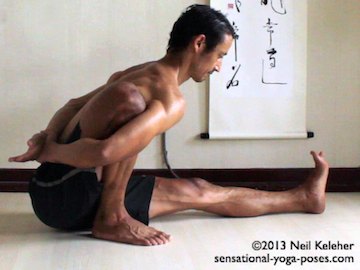
Marichyasana A (open twist)
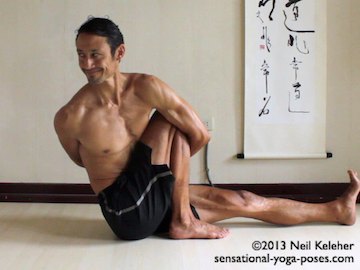
Marichyasana C
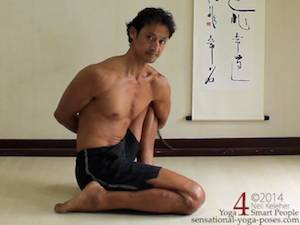
Marichyasana E
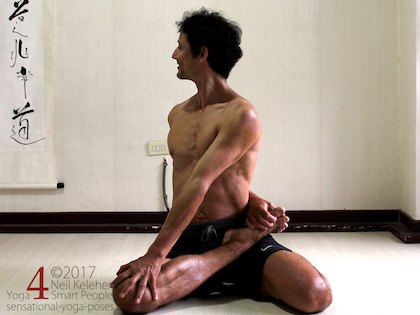
Bharad vajasana
A good way to prepare for spinal back bending yoga poses is to warm up with Spinal Back Bending Exercises.
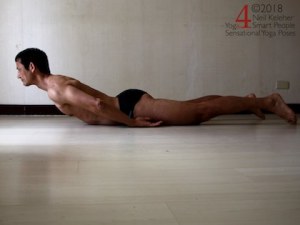
Locust pose
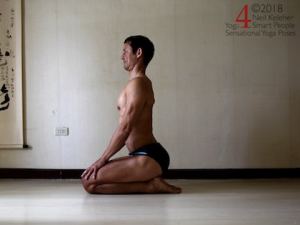
Kneeling spinal back bend
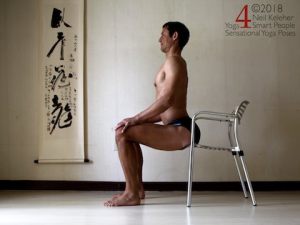
Seated spinal back bend
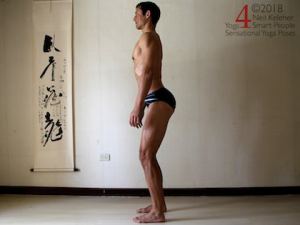
Standing spinal back bend
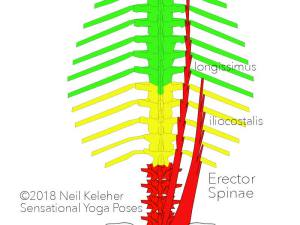
Spinal erectors
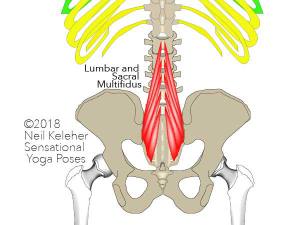
Back bending at the sacrum
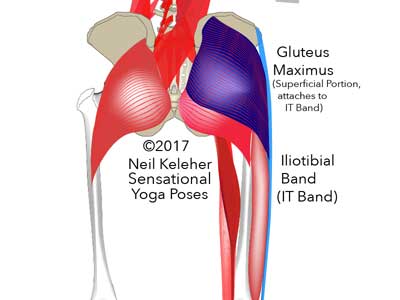
Glutes and hamstrings
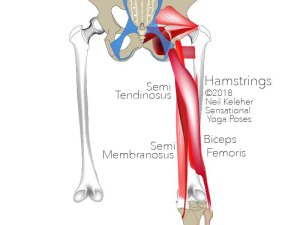
Hamstrings
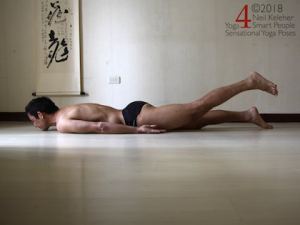
Locust pose leg lift
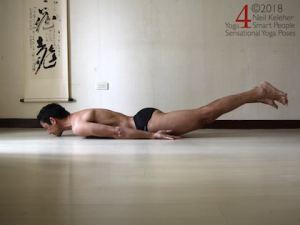
Locust pose dual leg lift/hip extension
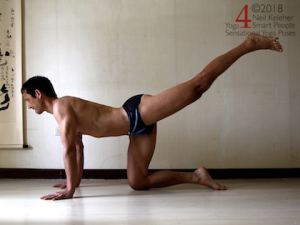
Cat pose leg lift/hip extension
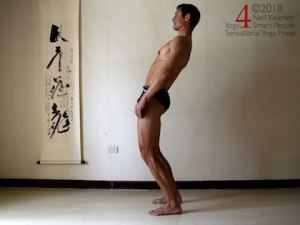
Standing hip thrust/hip extension
The idea is to use these exercises to help you feel your spinal erectors and activate them. You can then work at using your spinal erectors to actively bend your spine backwards while doing Spinal Back Bending Yoga Poses.
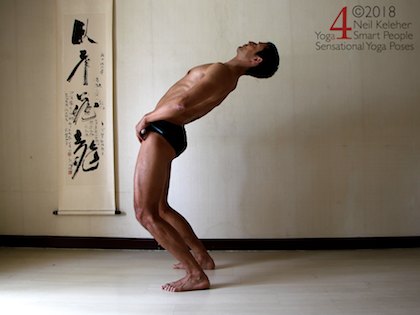
Standing back bend
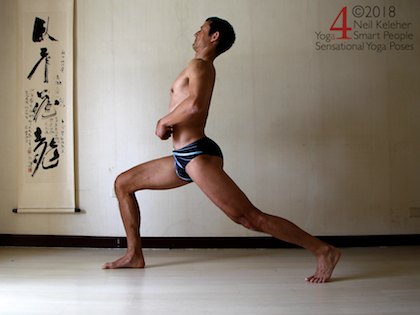
Upright lunging back bend
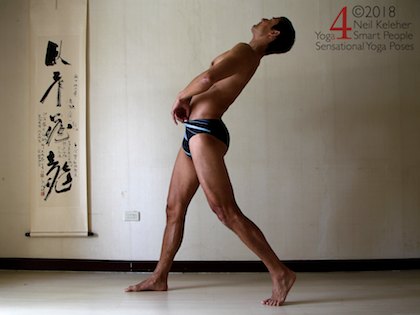
Straight leg lunge
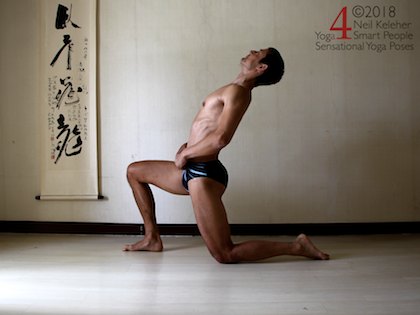
Semi-kneeling lunge
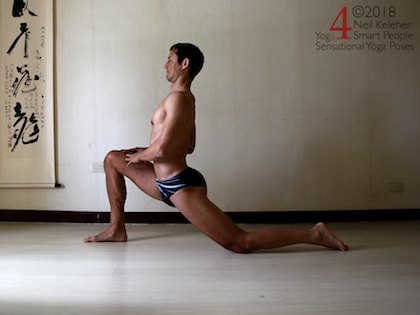
Deep lunge with back bend
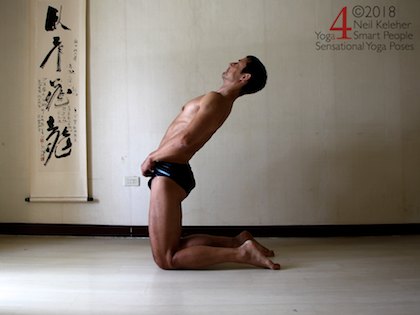
Camel pose variation
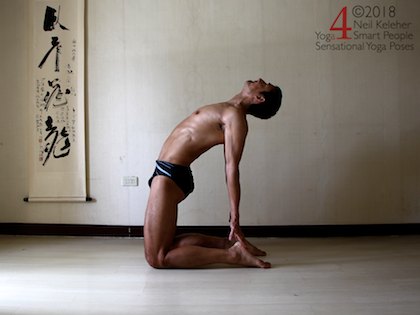
Camel pose w/ hands on heels
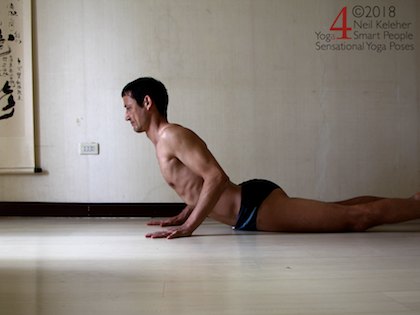
Cobra pose back bend
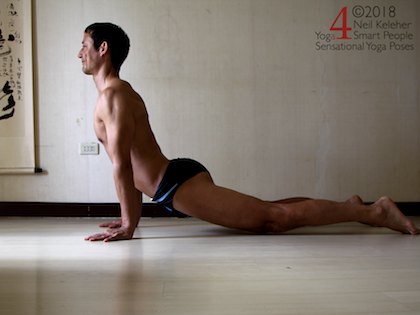
Up dog back bending pose
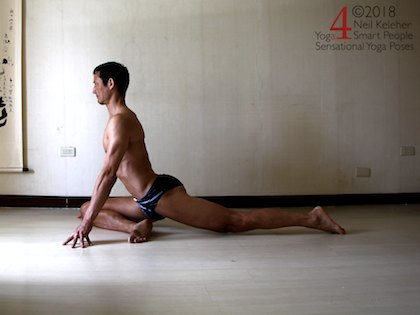
Upright pigeon back bend
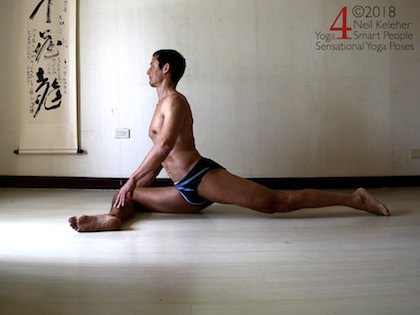
Upright pigeon variation
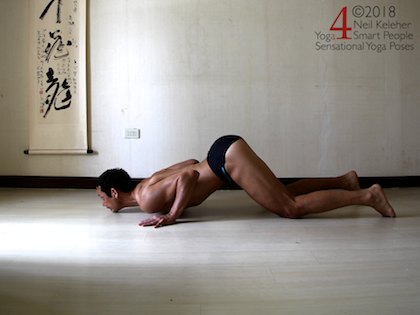
Puppy dog chest stretch
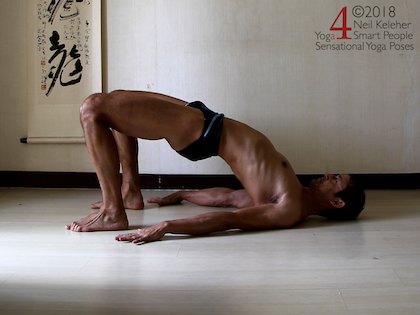
Bridge pose
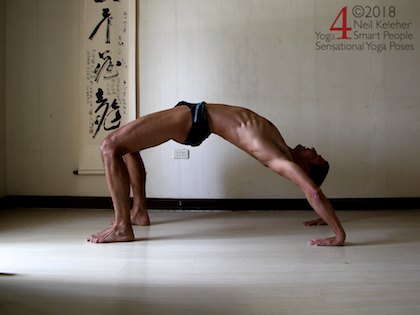
Wheel pose
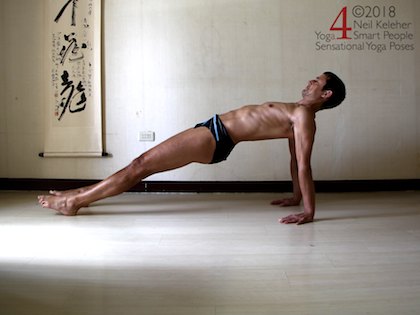
Reverse plank yoga pose
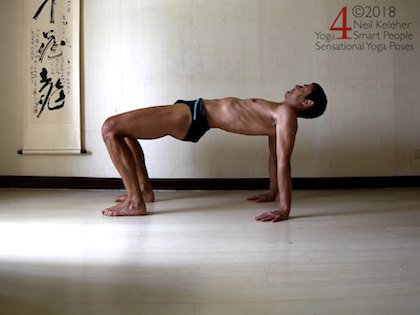
Table top yoga pose
Spinal back bending yoga poses can also include back bend for the hips.
Forward bending yoga poses can include a forward bend for the spine, a forward bend for the hips or a bit of both. Forward bends for the hips with the knees straight can be thought of as hamstring stretching yoga poses and they are listed in the next section.
The Yoga forward bends page includes poses like Yoga Plough Pose and shoulder stand (Salamba Sarvangasana) which are forward bends for the neck (and in the case of shoulder stand, also a forward bend for the hips). It also includes forward bends for the spine in general.
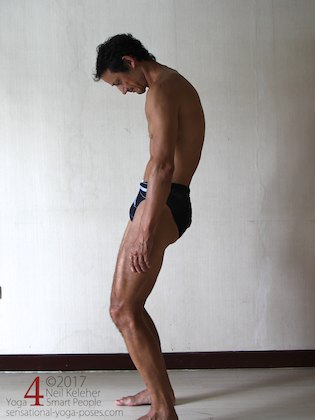
Standing spinal front bend
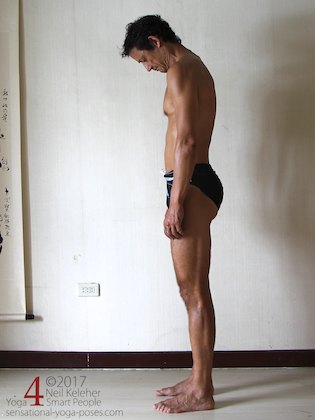
Forward bend for the neck
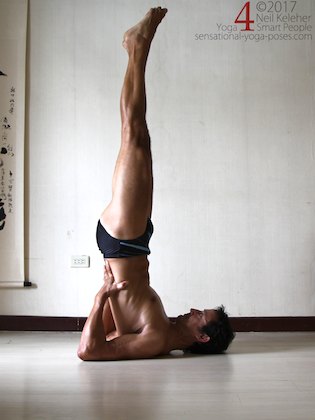
Shoulder stand
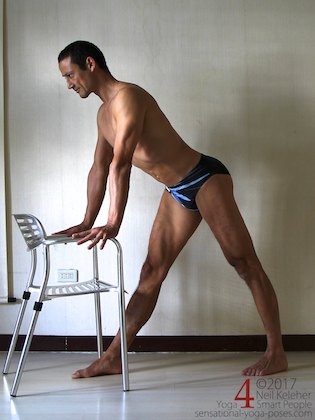
Pyramid pose
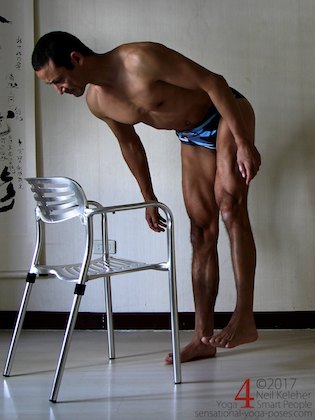
Forward bend with one leg lifted
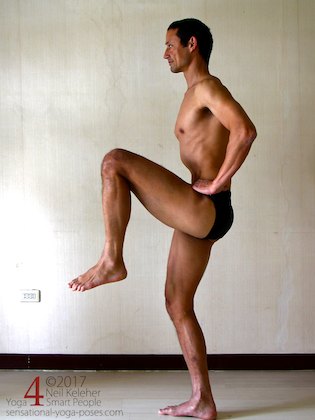
Standing knee lift
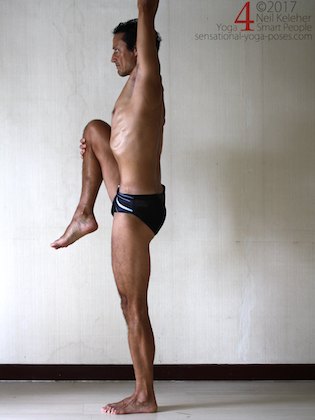
Standing knee hug
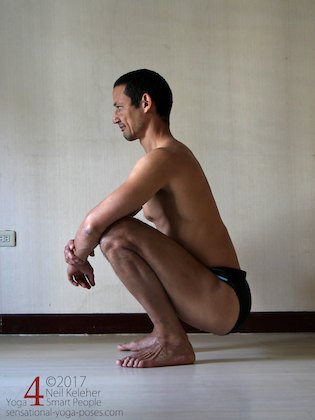
Squat
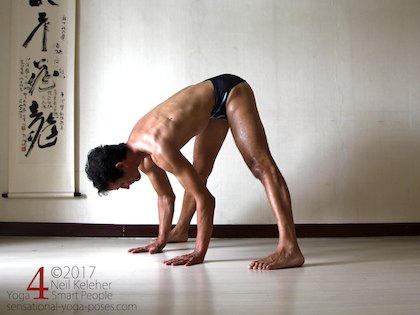
Standing wide leg forward bend
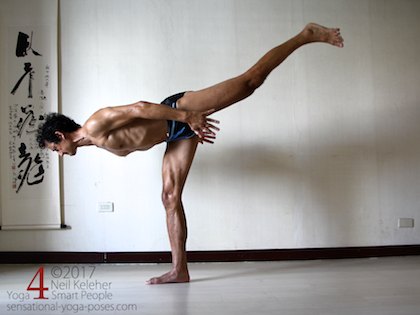
Warrior 3

Dog pose knee lift
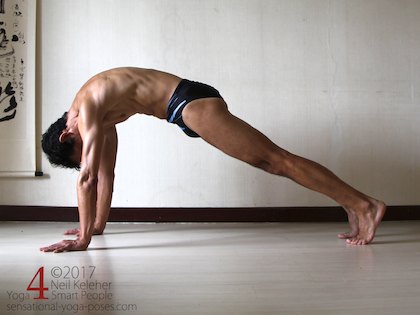
Plank pose with spinal forward bend
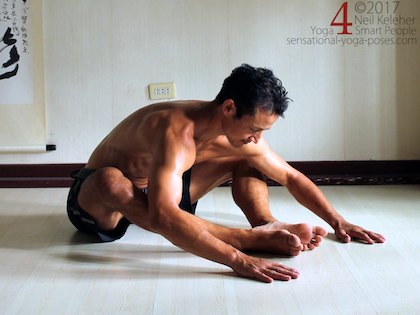
Wide bound angle pose
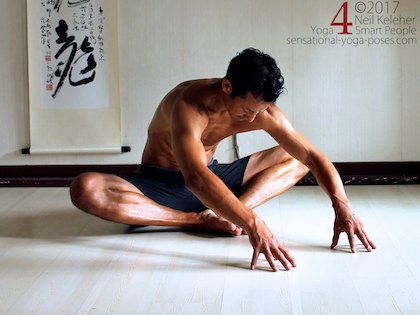
Bound angle pose
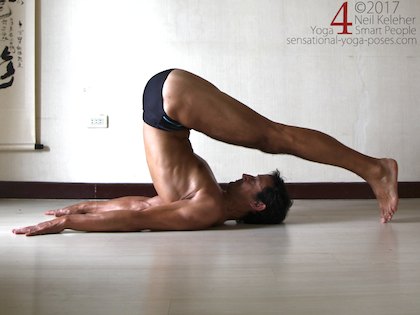
Plough pose forward bend for neck, hips
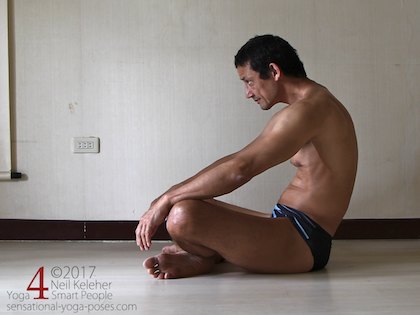
Seated spinal forward bend
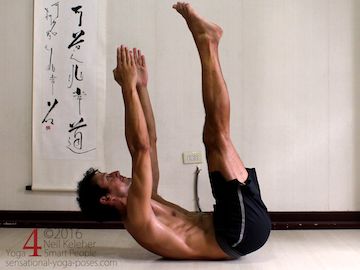
Dead dog spinal forward bend
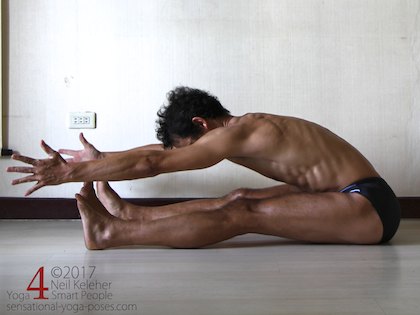
Seated forward bend
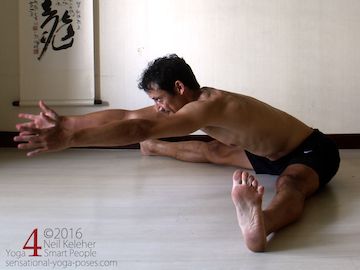
Seated wide leg forward bend
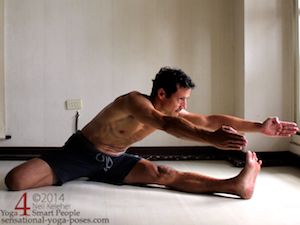
Hurdlers stretch
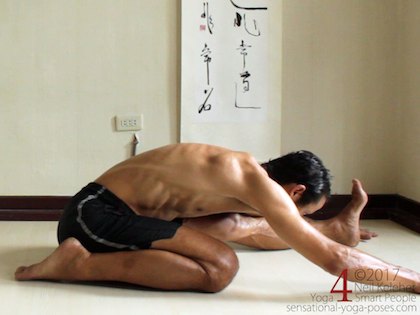
Half hero forward bend
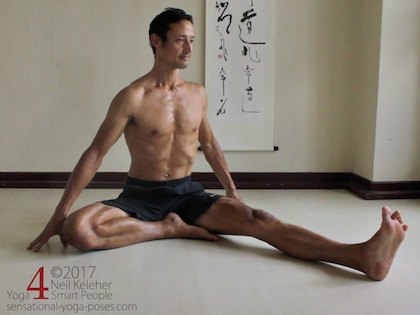
Janu sirsasana forward bends
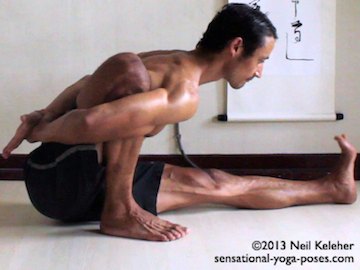
Marichyasana forward bends
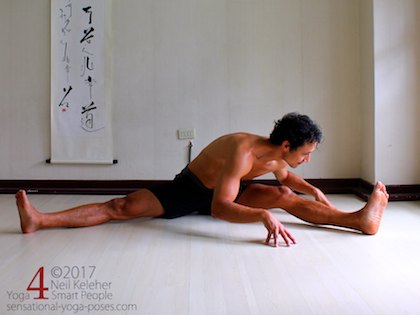
Wide leg forward bend to one leg
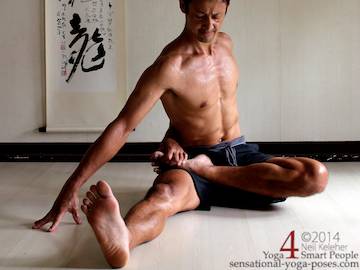
Seated half bound lotus
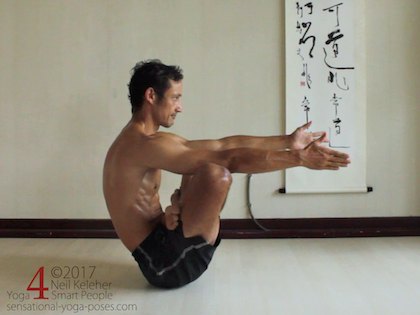
Seated lotus with knees to chest
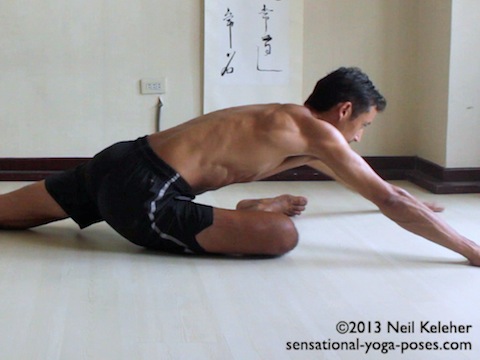
Pigeon pose forward bend
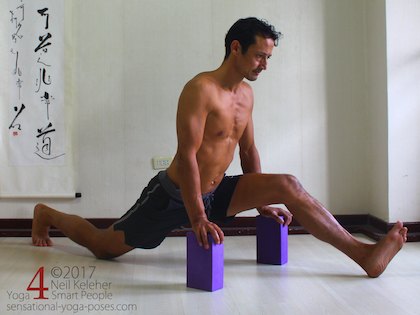
Splits
Forward bends for the hips with the knees bent can in some cases be used as Hip Flexor Strength Exercises. In other cases they can be used as a warmup or preparation for hamstring stretching yoga poses .
Hamstring stretching yoga poses are poses where you bend forwards at the hips with the knees straight in order to stretch the hamstrings.
Because hamstring stretching isn't always easy, hamstring stretching yoga poses includes different suggestions for stretching the hamstrings effectively.
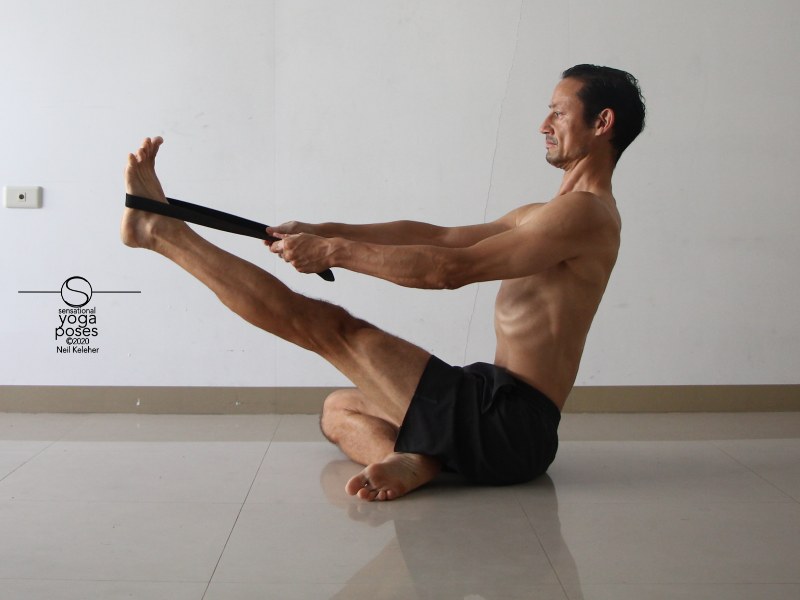
Using a belt
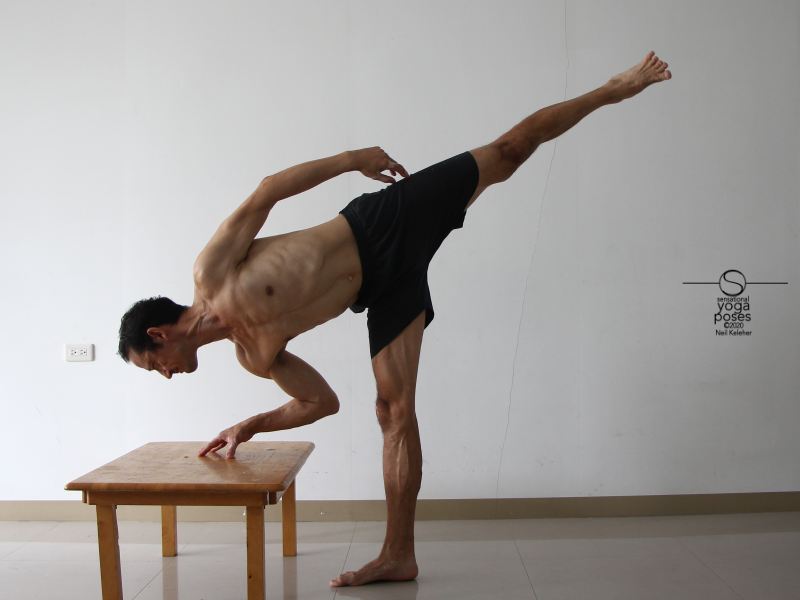
Half moon
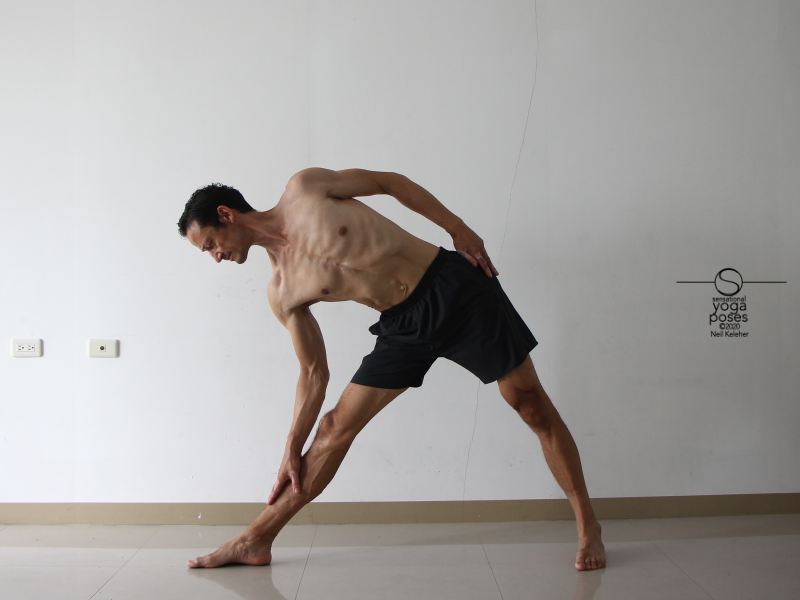
Triangle pose
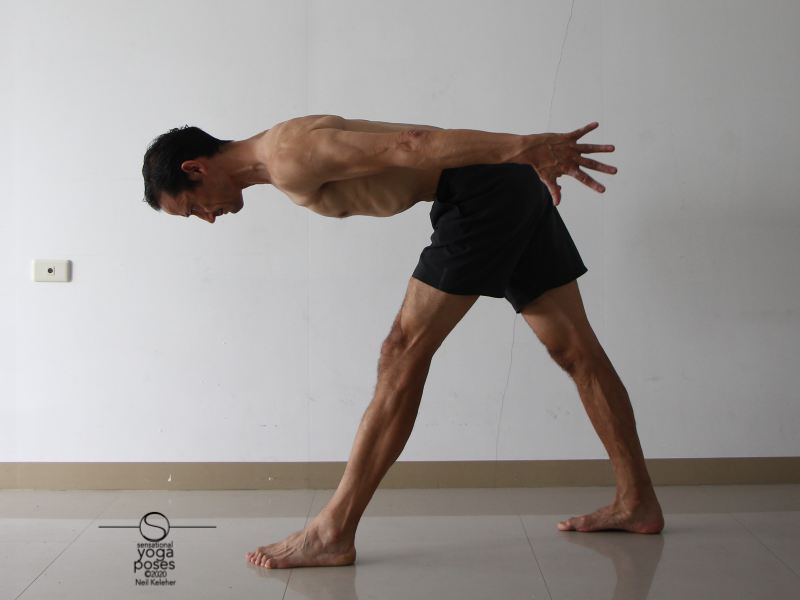
Pyramid pose
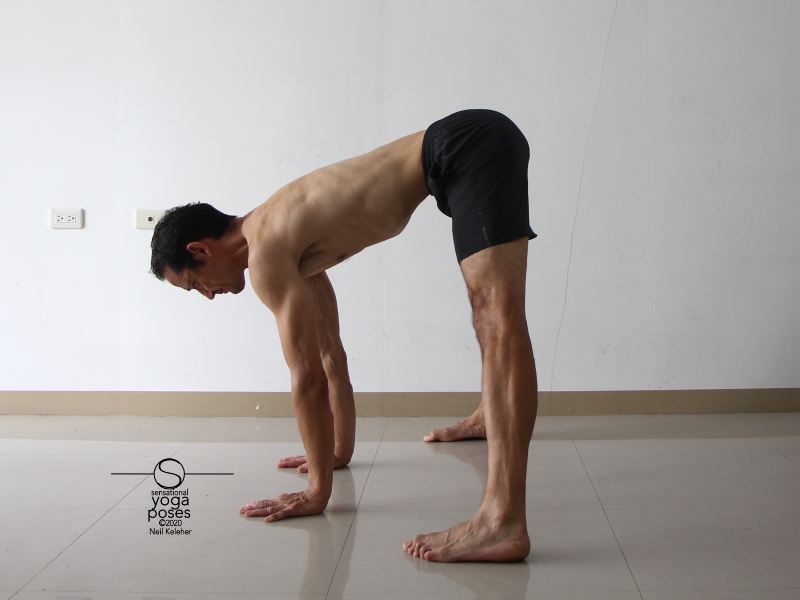
Wide leg forward bend
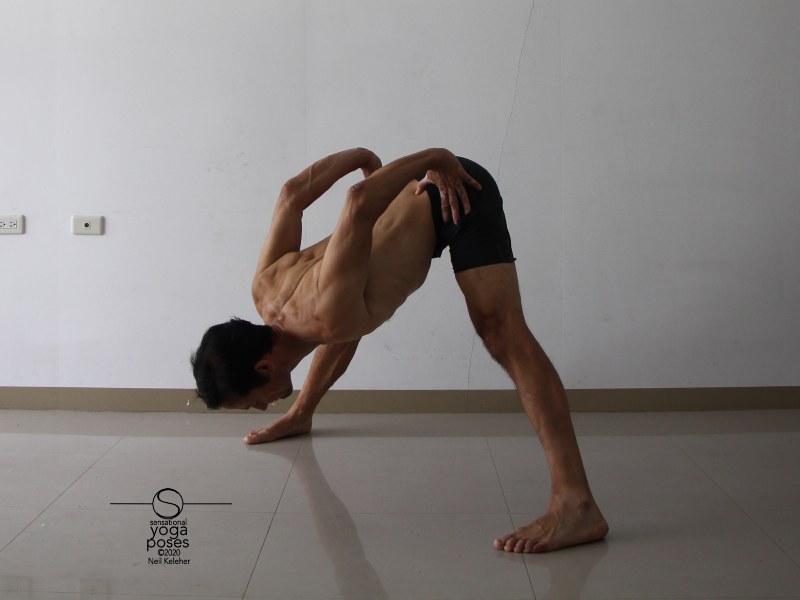
Prassaritta padotanasana B
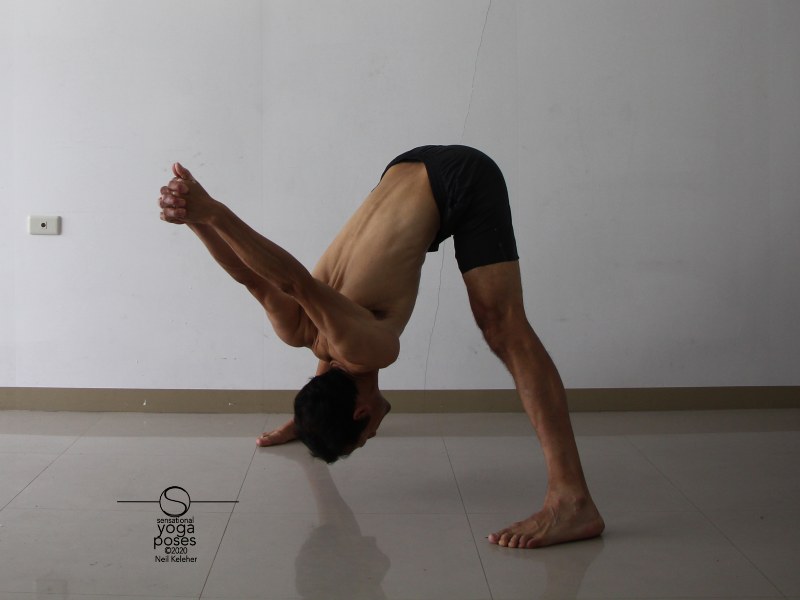
Prassaritta padotanasana C
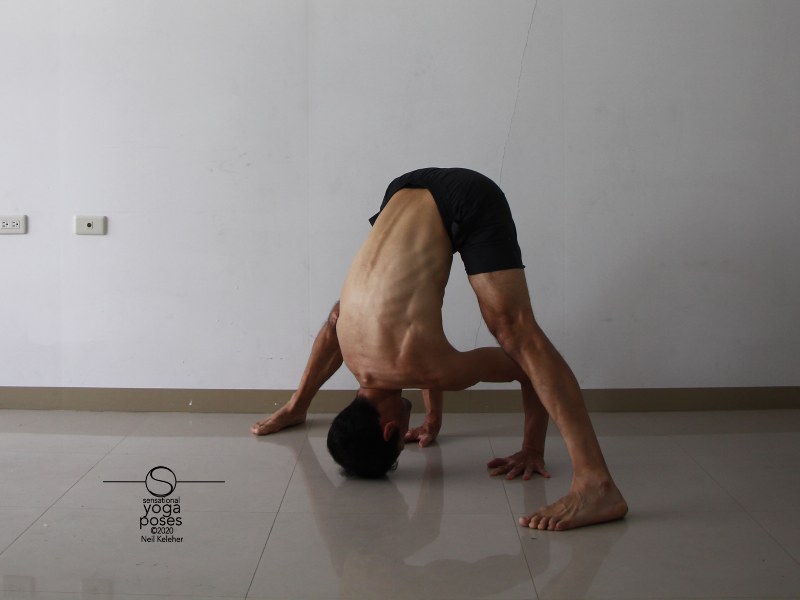
Prassaritta padotanasana A
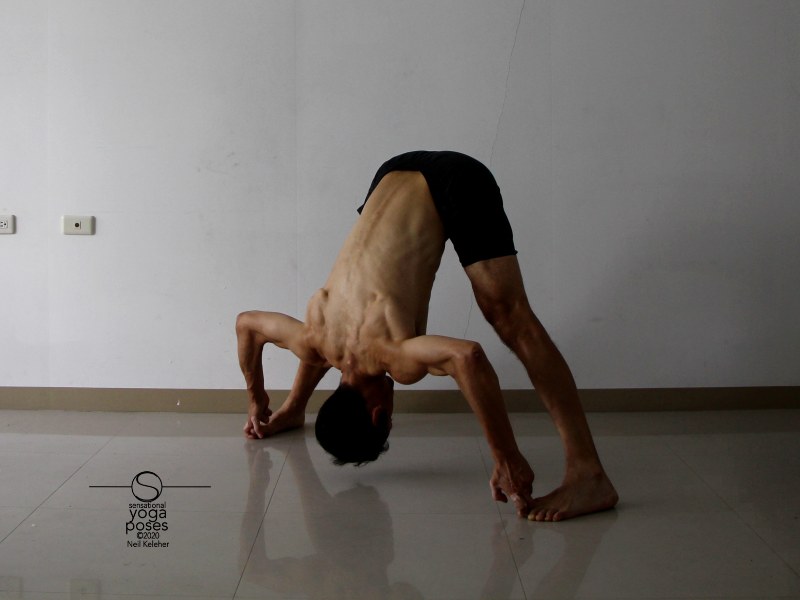
Prassaritta padotanasana D
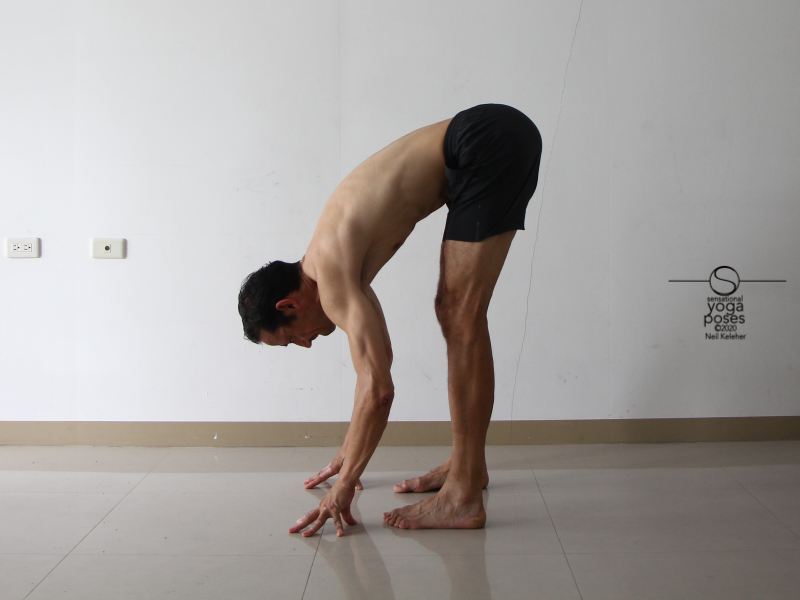
Standing forward bend
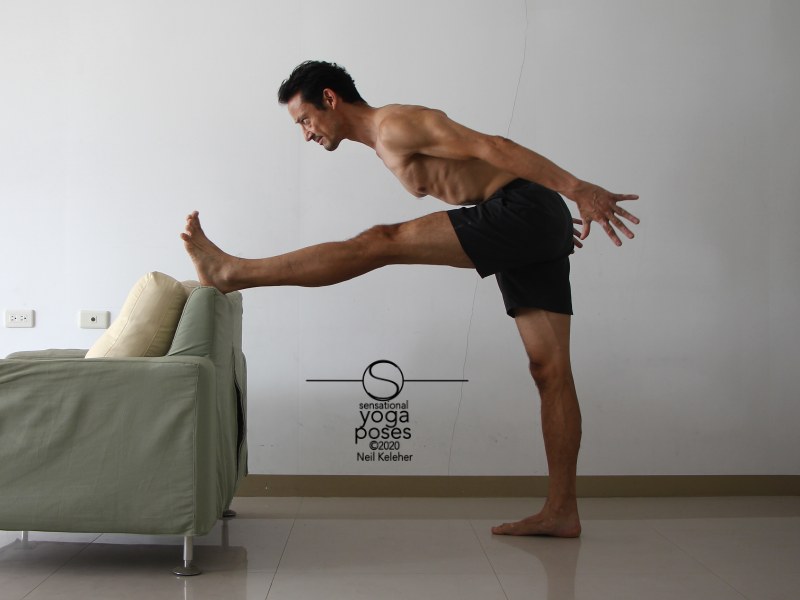
Raised leg standing forward bend
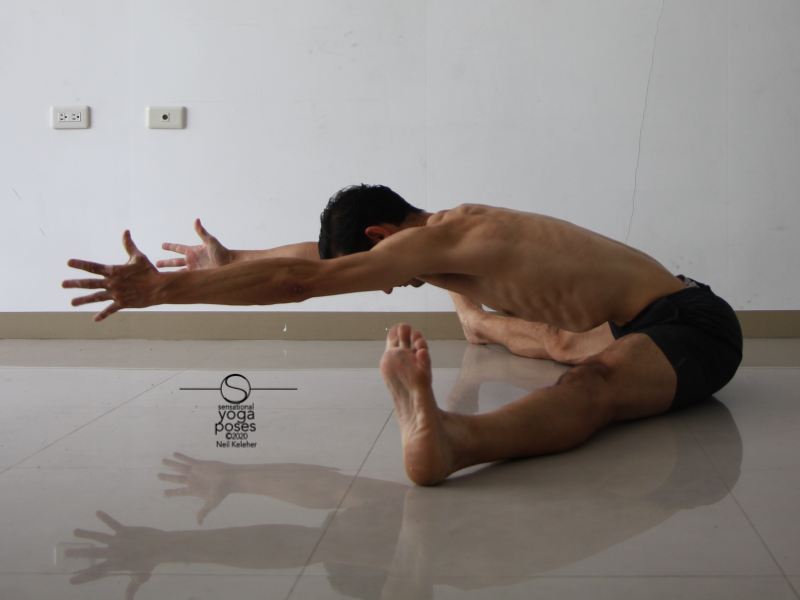
Wide leg seated forward bend
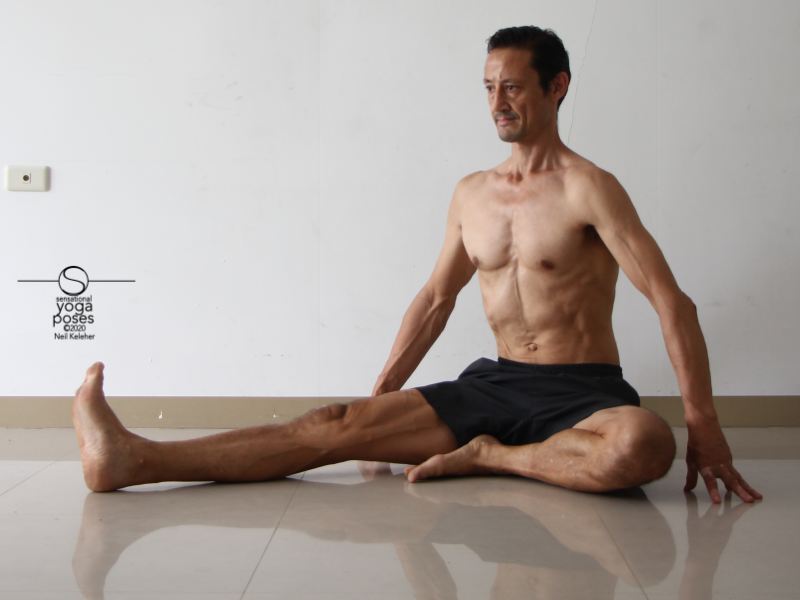
Janusirsana A
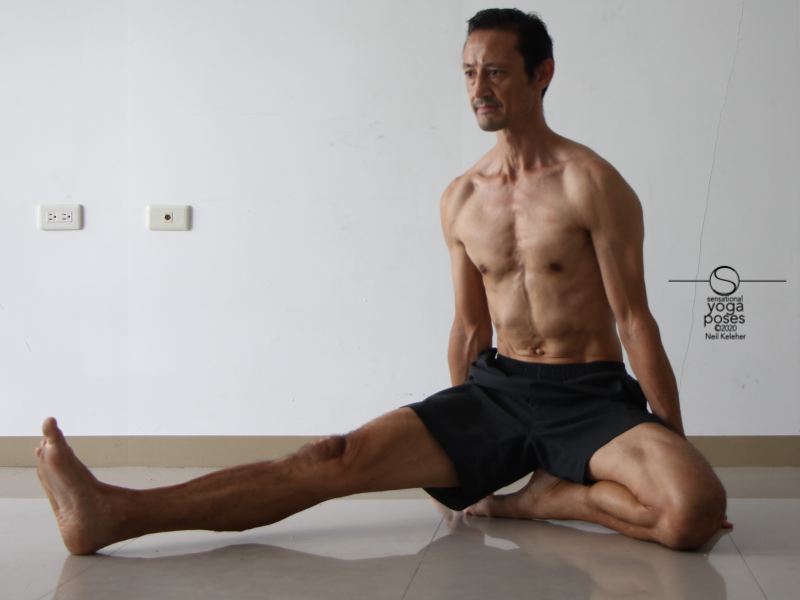
Janusirsana B
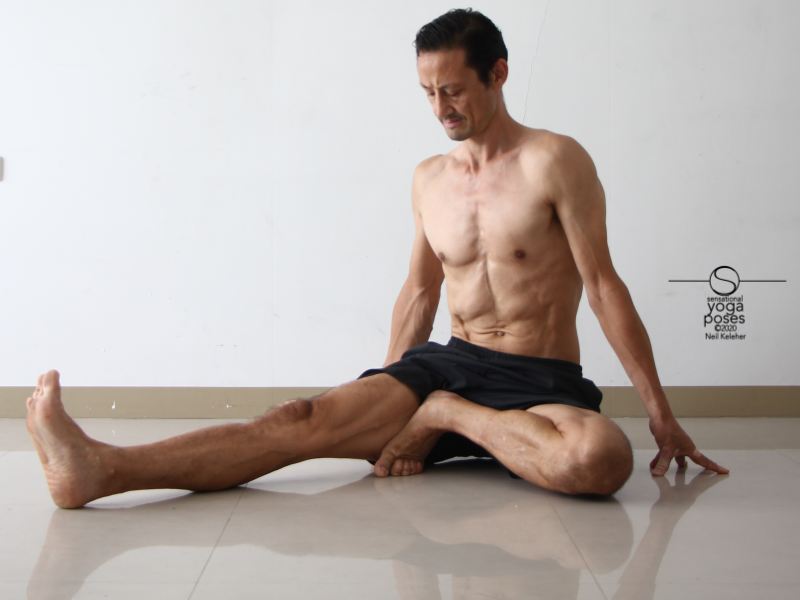
Janusirsana C
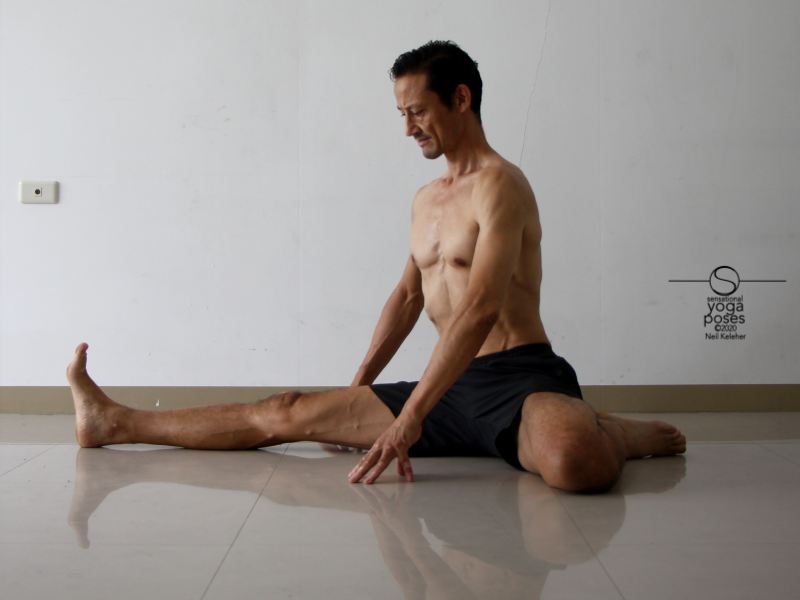
Hurdlers' stretch
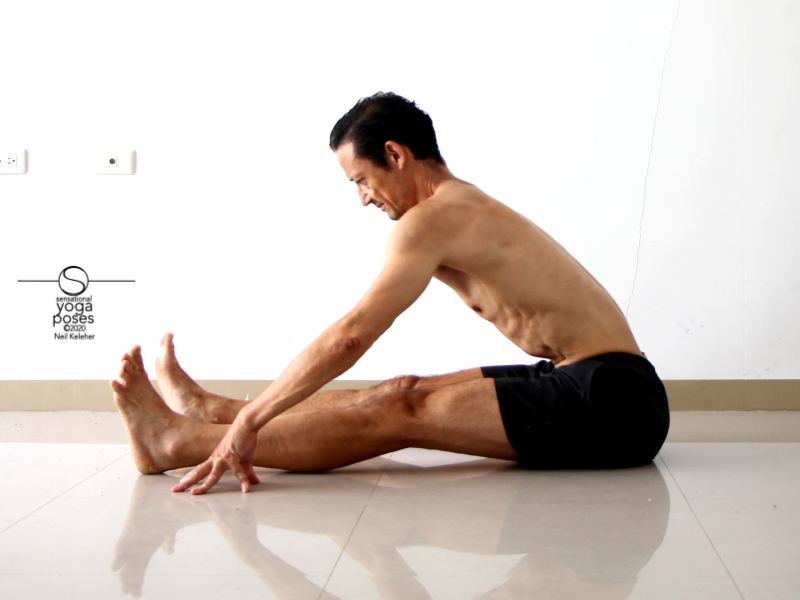
Seated forward bend
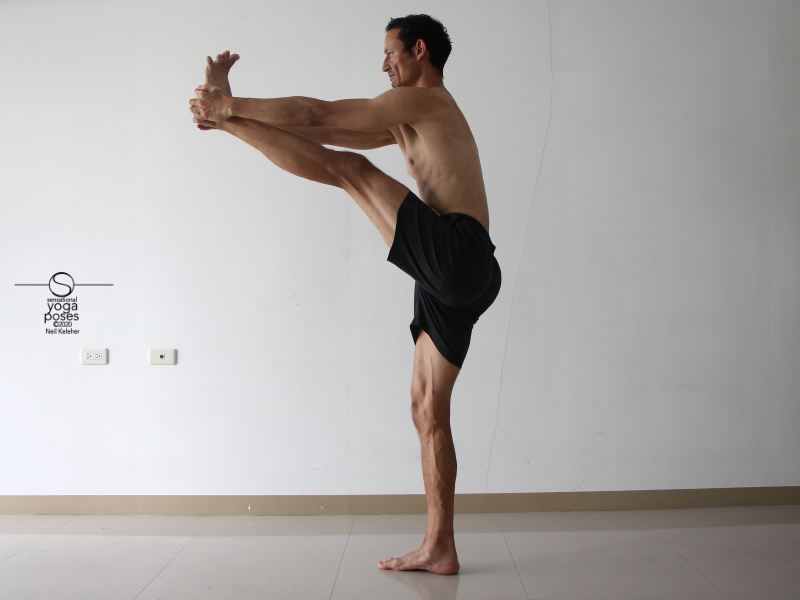
Leg lifted standing hamstring stretch
If you are interested in working towards front to back splits, then check out these hamstring stretches specifically.
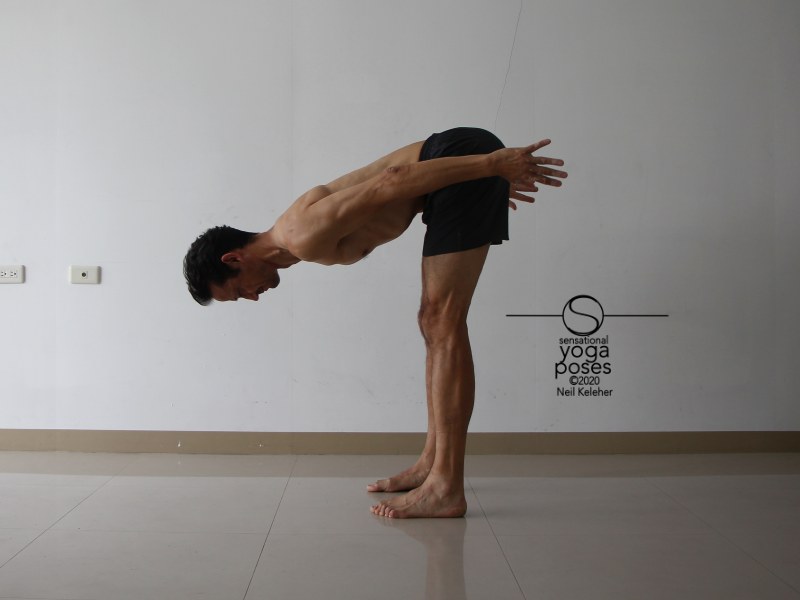
Standing forward bend
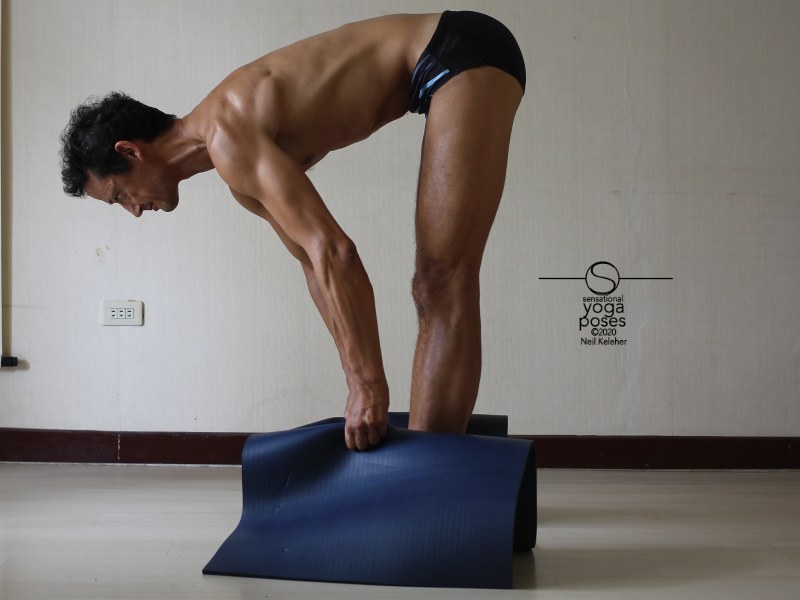
Standing f-bend using arms
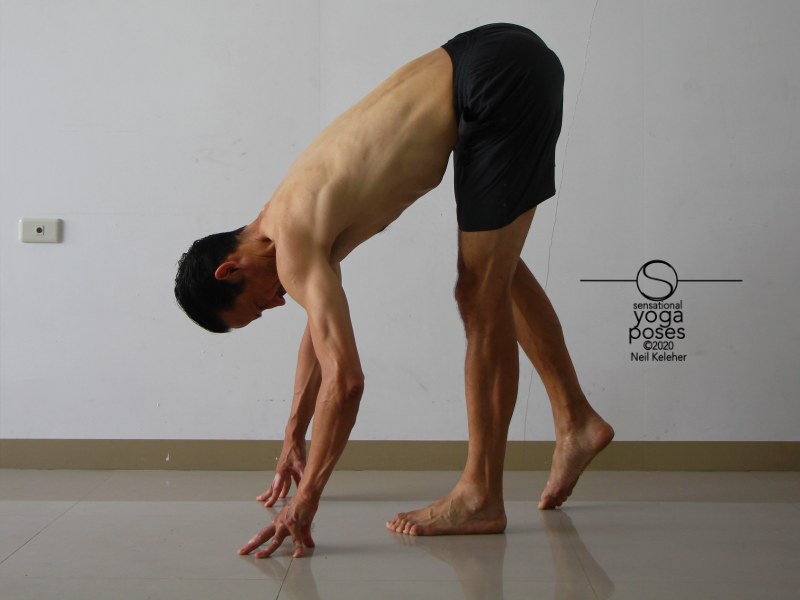
Standing f-bend on one leg
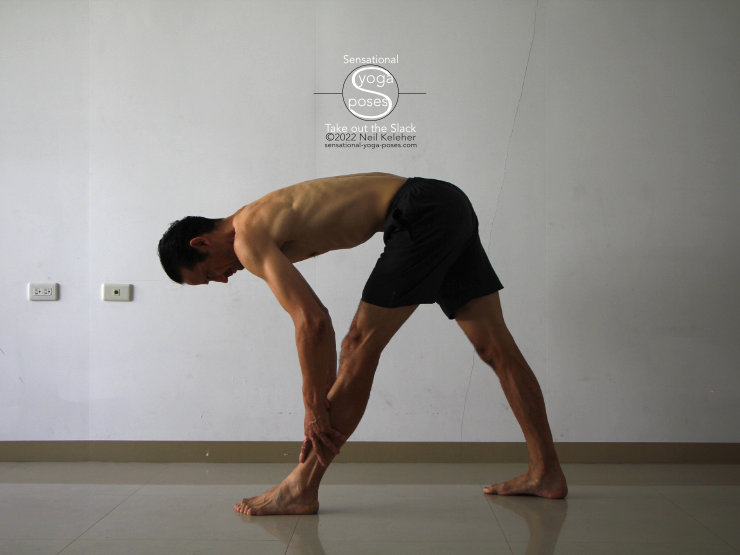
Pyramid pose hamstring stretch

Leg supported
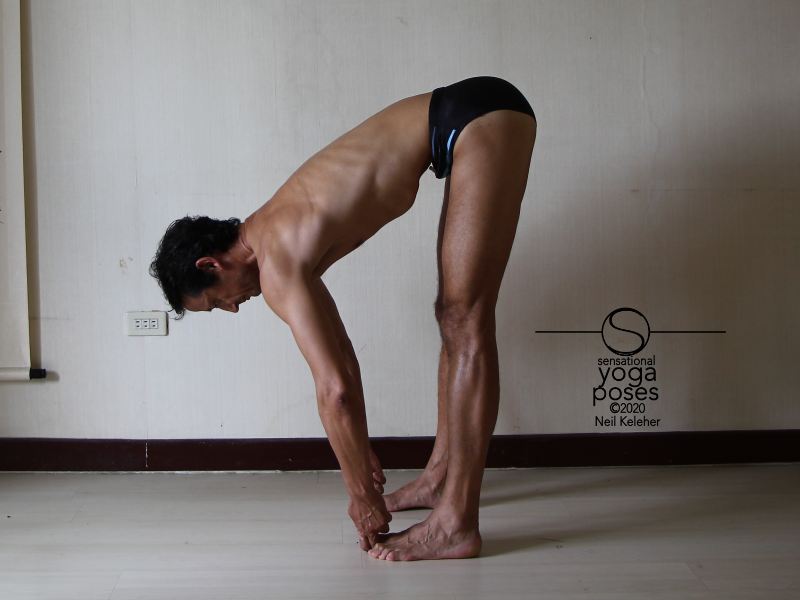
Spine long TA engaged
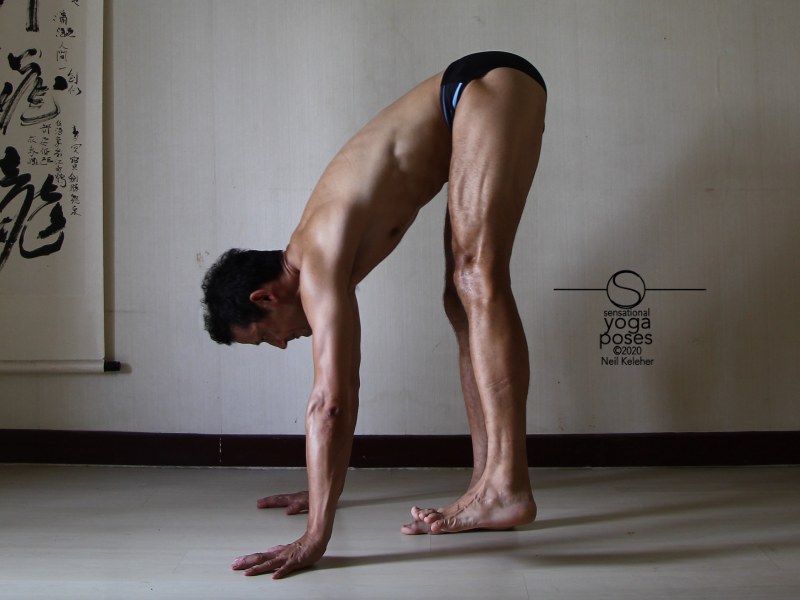
Pulling lifted leg fwd
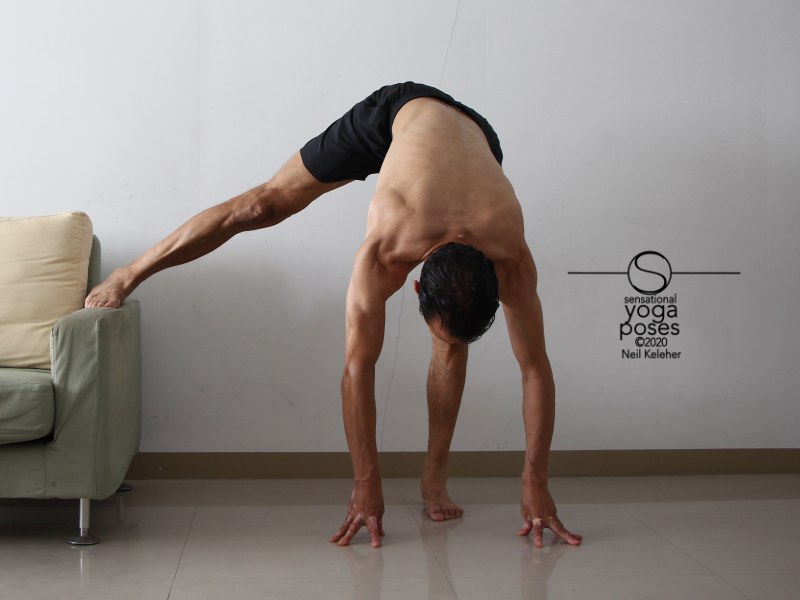
Bending down to standing leg
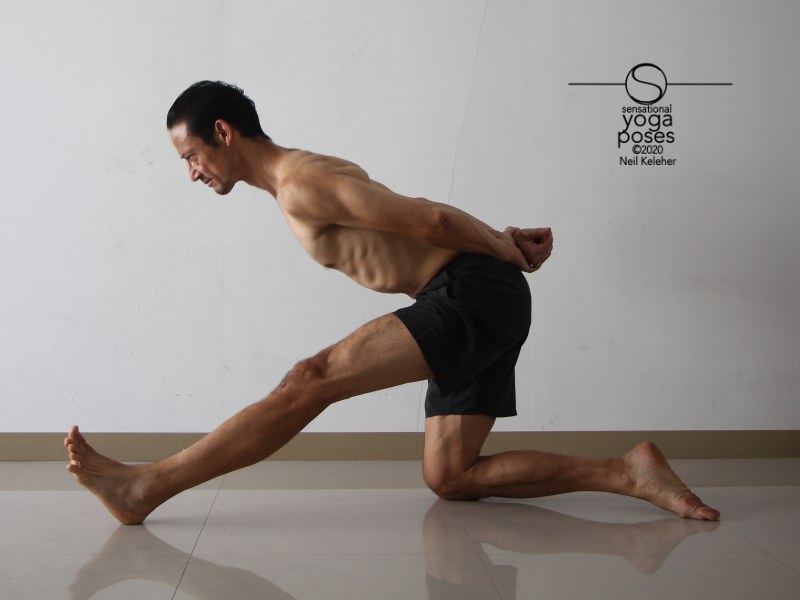
Semi-kneeling w/ hips lifted
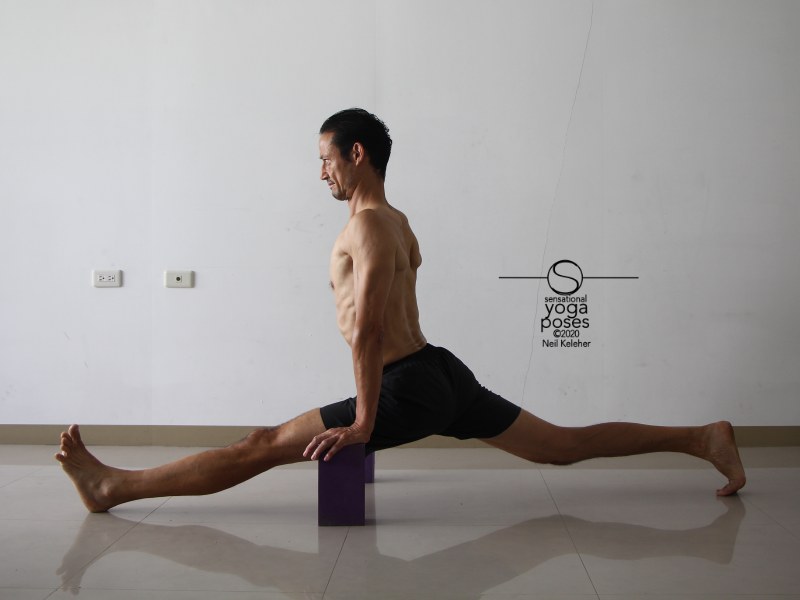
hamstring and hip flexor splits
Binding yoga poses are those where one hand grabs the some part of the opposite arm, or it grabs a foot or shin.
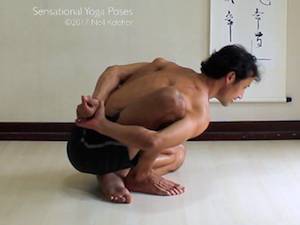
Modified marichyasana B
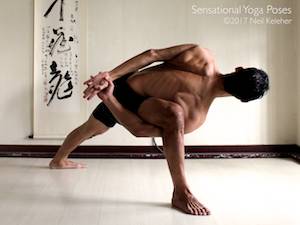
Bound side angle pose
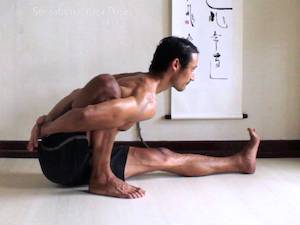
Marichyasana A pose
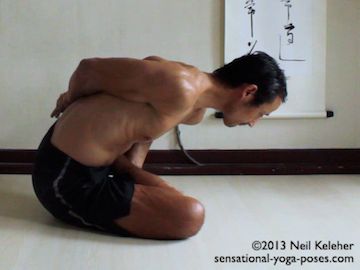
Marichyasana B pose
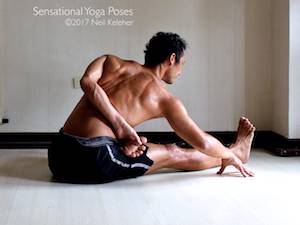
Seated bound half lotus
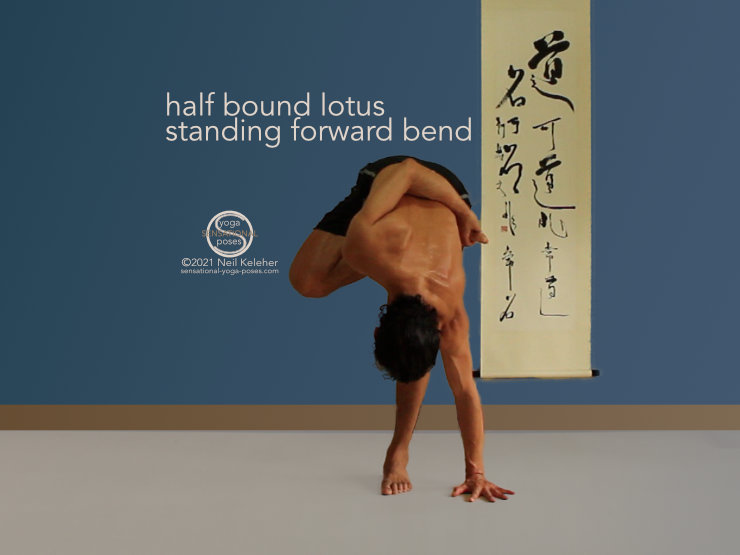
Standing bound half lotus
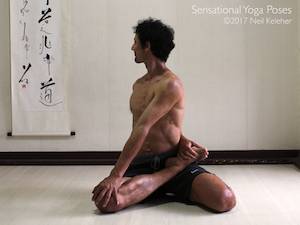
Bharadvajasana binding pose
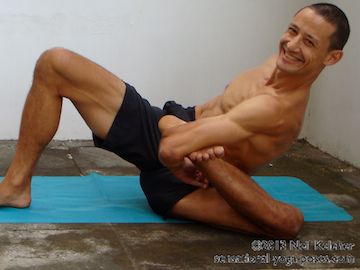
Armpit pose
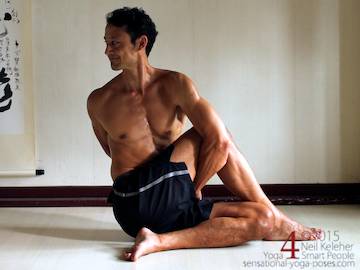
Variation: Ardha matsyendrasana
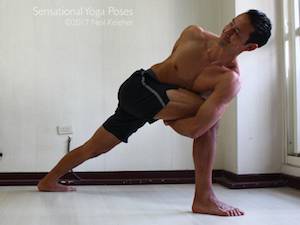
Bound twisting side angle
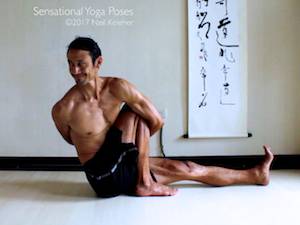
Marichyasana C yoga pose
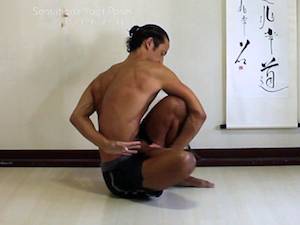
Marichyasana D attempt
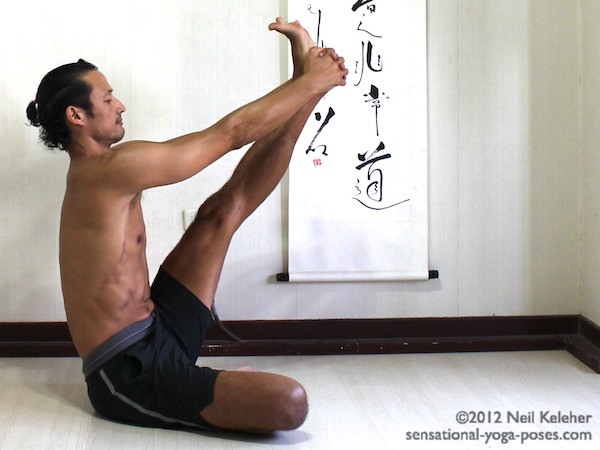
Compass yoga pose prep
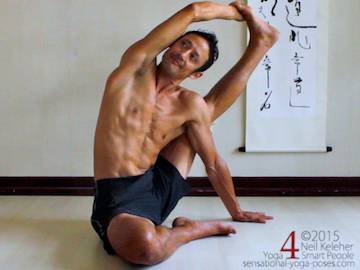
Compass yoga pose
Binding yoga poses also include poses where one foot or leg presses against the opposite foot or leg such as yoga tree pose and eagle pose.
And actually, eagle pose includes a bind for the legs and also for the arms as explained in eagle pose arms.
In binding poses like the marichyasana series you wrap an arm around a bend leg in the process of grabbing the wrist of the opposite hand.
Arm supported yoga poses are those where the arms are used to support some portion of the weight of your body.
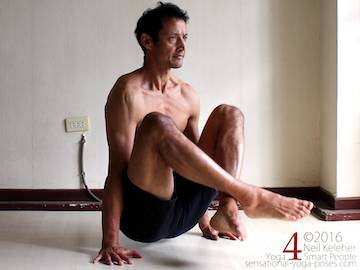
Lifting up/dangle pose
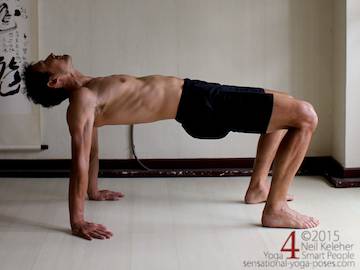
Table top pose
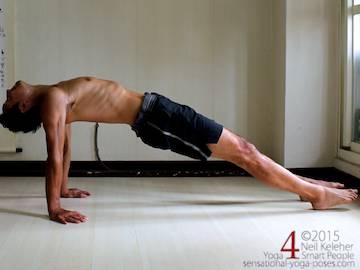
Reverse plank
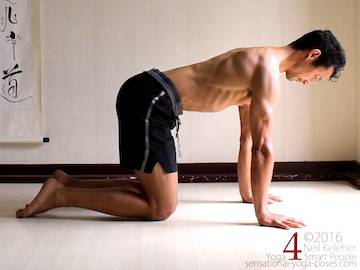
Cat pose
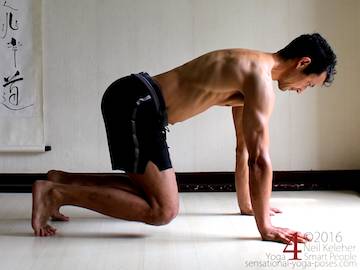
Dog pose knee lift
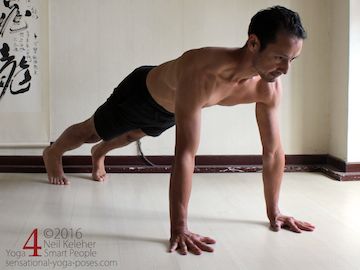
Plank
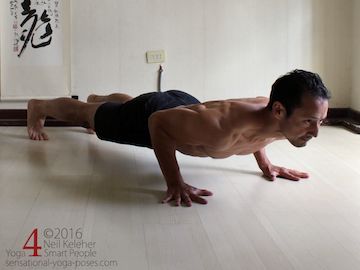
Chaturanga
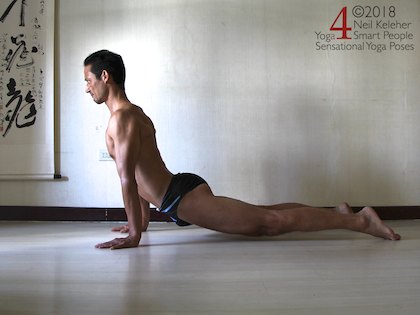
Upward facing dog and Cobra pose
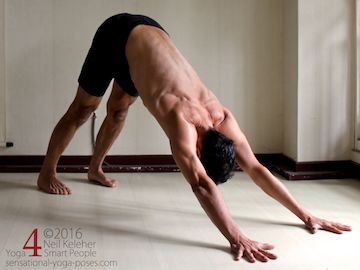
Downward dog
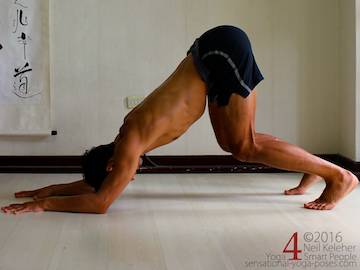
Dolphin pose
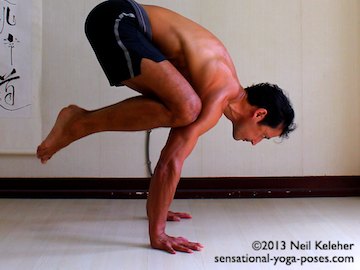
Crow pose
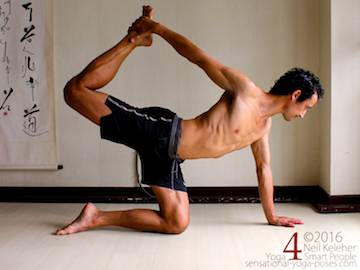
Balancing cat/bow pose
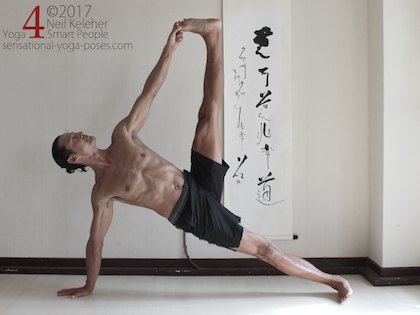
Side plank
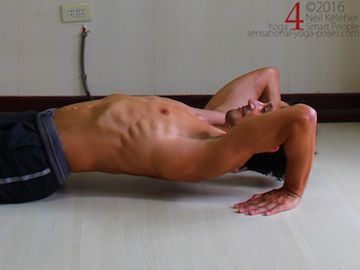
Reverse push up
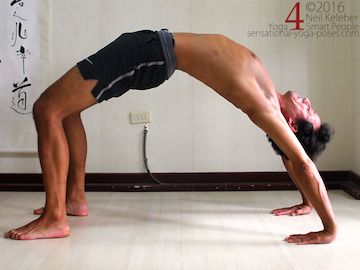
Wheel pose
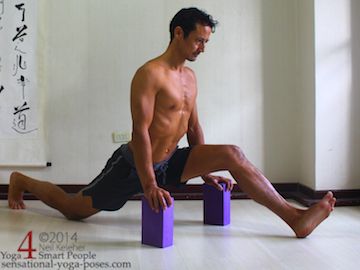
Arm supported front splits
These poses can be used to strengthen the arms and shoulders.
Note that the positions included here include positions with arms in front of the body (Dog, plank, Chaturanga, Upward Facing Dog, Bird Dog Yoga Pose), behind it (Reverse Plank Yoga Pose and Table Top Yoga Pose), reaching past the head (Downward Facing Dog and Dolphin) and to the side (Side Plank).
The arm supported poses where one hand is grabbing a foot or big toe could also be considered as binding yoga poses.
Arm balances are yoga poses where the weight of the body is supported by the body. They include yoga poses with names like galavasana, eka pada bakasana and astavakrasana.
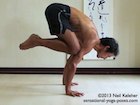
Crow pose
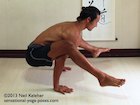
Tittibasana/ firefly
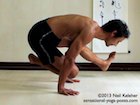
Eka pada koundinyasana
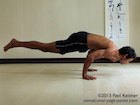
Eka pada koundinyasana
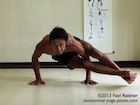
Astavakrasana
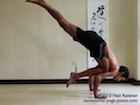
Eka pada bakasana 1
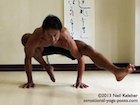
Eka pada bakasana 2
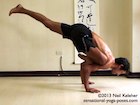
Galavasana
Handstand is not included in this group of poses because arm balances tend to have one or both legs in contact with the arms. In this regard, because of the inter-body contact, arm balances could be thought of as being similar to binding yoga poses.
One pose that sort of breaks the rules for arm balancing (in that the waist rests on the arms, not the legs) is mayurasana.
Note that arm balances for the most part could also be thought of as belly down yoga poses since the belly does face downwards in most arm balancing yoga poses.
For more arm balancing yoga poses, scroll sideways through the list below.
Kneeling yoga poses are those where one or both shins are on the floor with the knees bent and with some portion of the weight of the body being supported by the shin(s) or knee(s) in question.
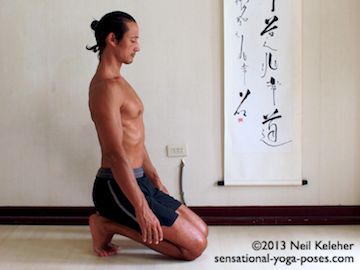
Kneeling w/ toes tucked
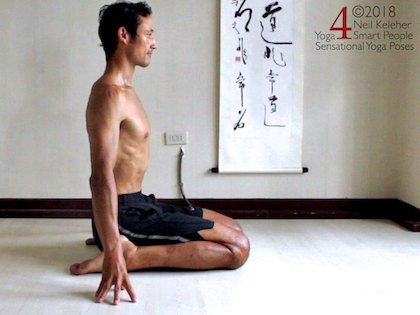
Hero pose
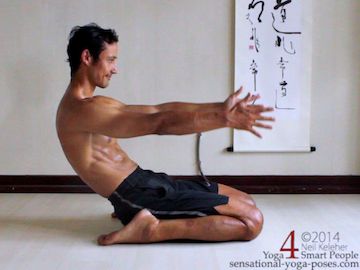
Bent back hero pose
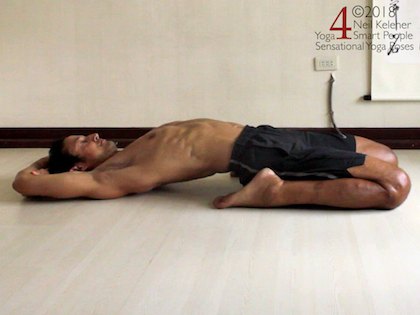
Reclining hero pose

Bharad-vajasana
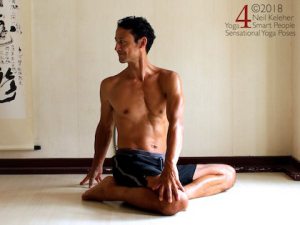
Mod. bharad-vajasana
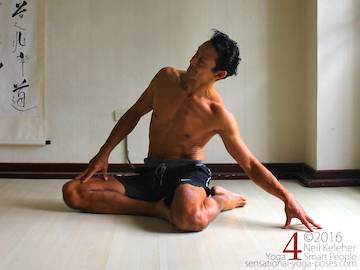
Options
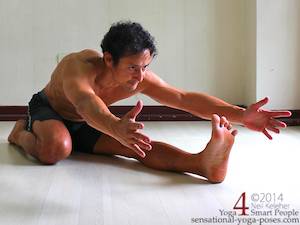
Half hero forward bend
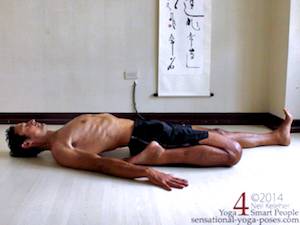
Reclining half hero
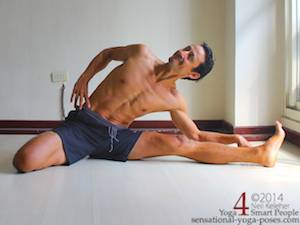
Half hero side bend

Marichyasana E
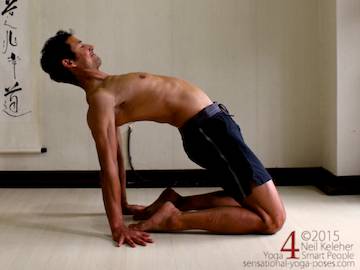
Camel pose

Dog pose (lifted knee cat pose)
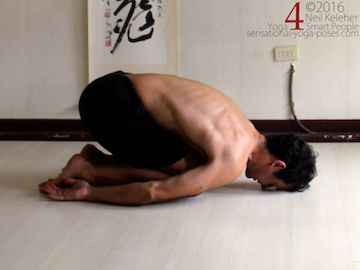
Child's pose
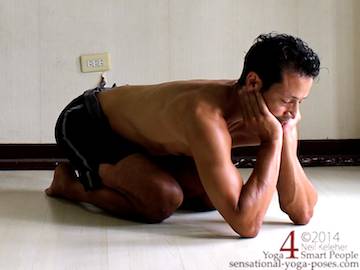
Child's pose variant
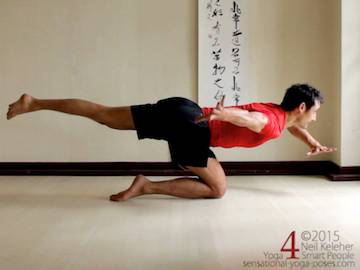
Shin balance
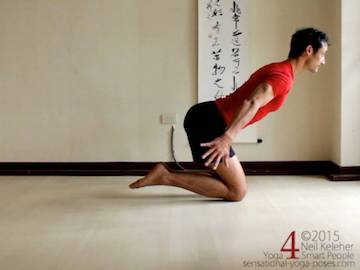
Knee balance
Kneeling poses also include poses where one or both legs are in the "hero" foot position. This is where the foot (and shin) are positioned to the outside of the thigh.
Kneeling and semi-kneeling yoga poses can include twisting yoga poses as well as side bending yoga poses. Forward and backward bends are also included.
Kneeling poses can be used to stretch the quadriceps. For a deeper quadriceps stretch while kneeling or while in hero pose, you can lean back at the hip joints.
Belly down or prone yoga poses are those where the body is positioned so that the belly faces downwards. You could be supporting the torso using arms or legs, or the belly can be in direct contact with the floor. Some of the belly down positions can be used as shoulder stretches. In one case, the shoulder stretch starts from a belly down position, but then as you enter the pose, the belly ends up facing the side, or even upwards.
Prone yoga poses (or belly down poses) include some backbending poses as well as poses that could be considered binding poses since hands are used to grab feet or ankles.
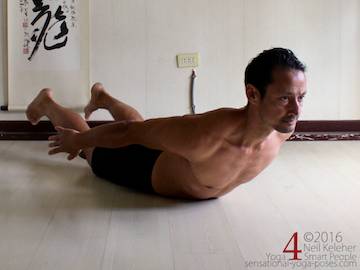
Locust pose
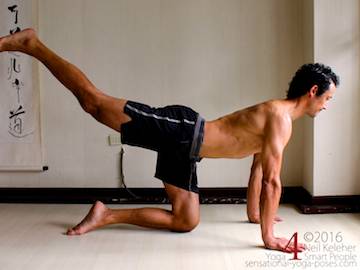
Extended cat pose

Dog pose knee lift

Plank pose
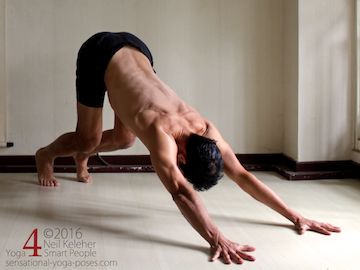
Downward dog
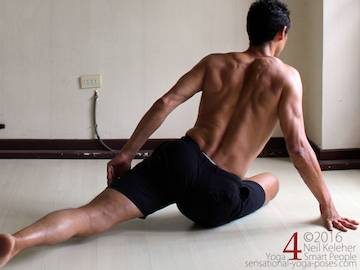
Upright pigeon
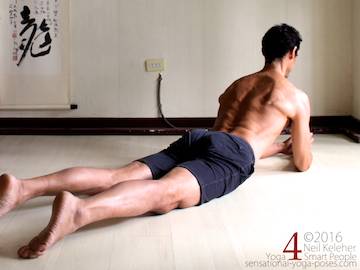
Cobra pose
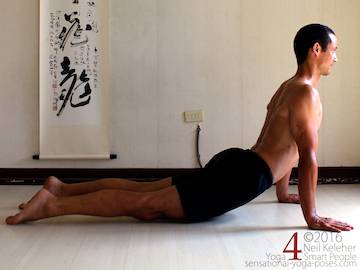
Upward dog

Chaturanga dandasana
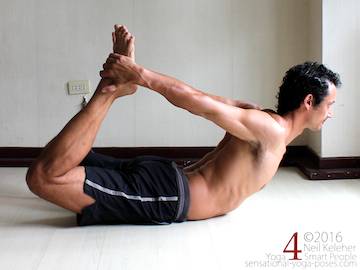
Bow pose
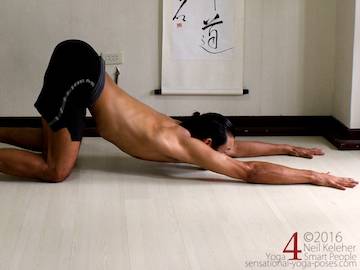
Puppy dog pose
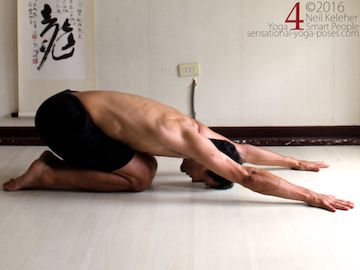
Child's pose
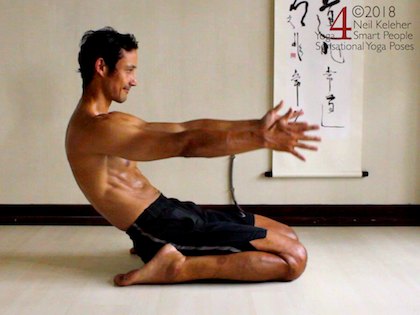
Bent back hero pose
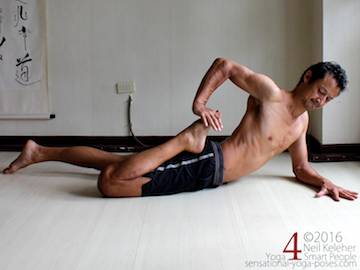
Frog pose
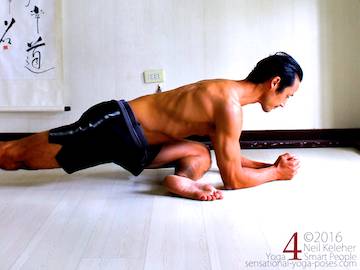
Pigeon pose
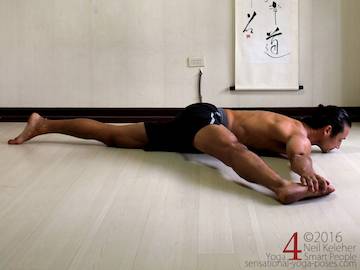
Prone big toe pose
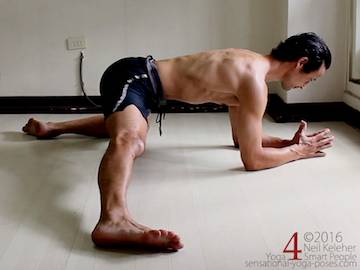
Half side split
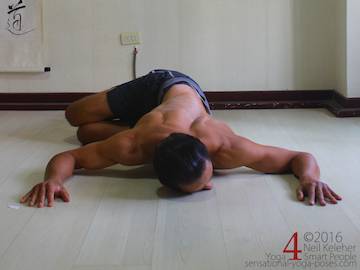
Prone twist
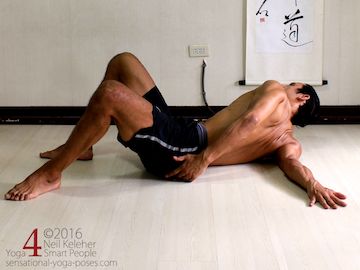
Lapasana shoulder stretch
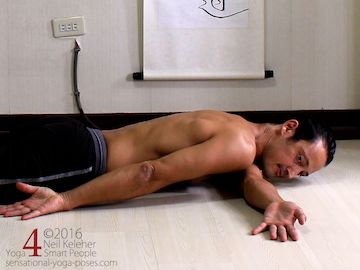
Half dragonfly arm stretch
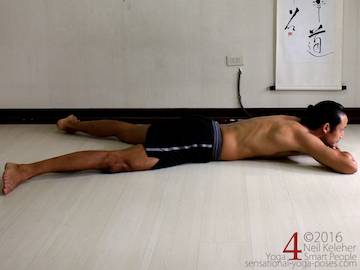
Prone resting poses
In general, the prone yoga poses here can be used for stretching and strengthening quads, hip flexors, outer hips, adductors, spinal twists and shoulder stretches. Note that these poses can combine stretching and strengthening when you resist the stretch by activating the muscles you are trying to stretch.
Prone poses can also include resting poses.
Supine yoga poses are poses where the belly faces upwards.That includes poses that are supported by the arms and/or legs.
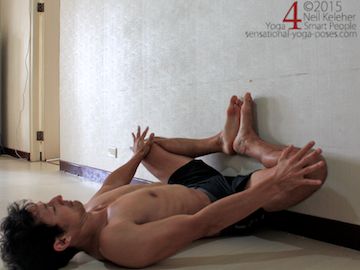
Feet on wall bound angle
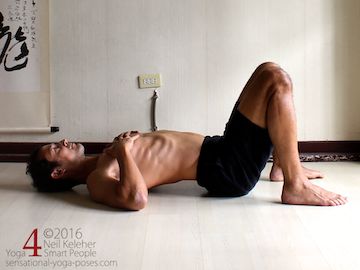
Supine lumbar extension
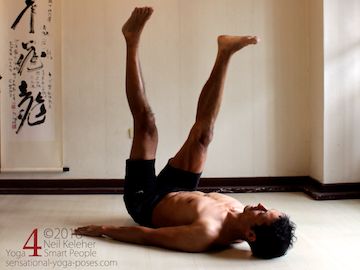
Supine hip flexion 1
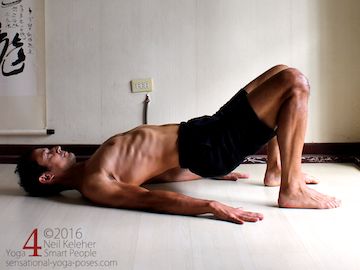
Supine lumbar extension 2
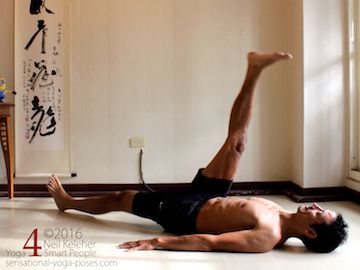
Supine hip flexion 2
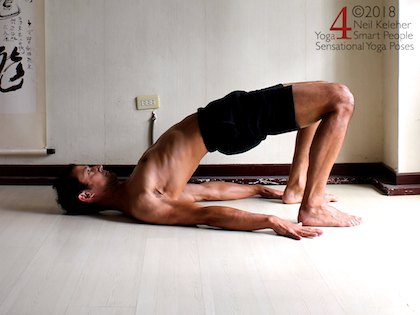
Supine lumbar extension 3
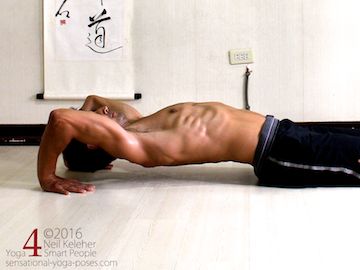
Reverse push up

Dead dog reach
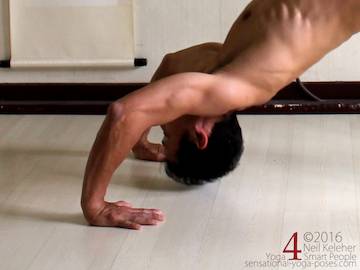
Crown reverse push up
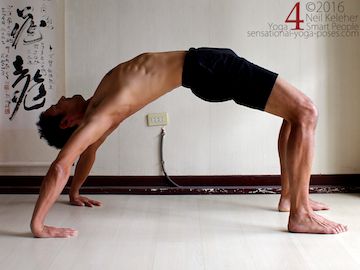
Wheel pose
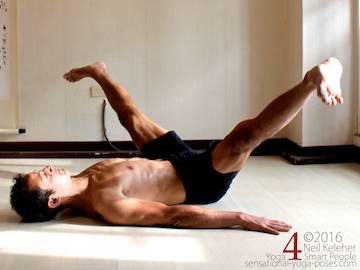
Supine side splits
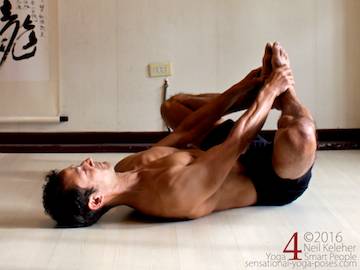
Supine bound angle foot grab
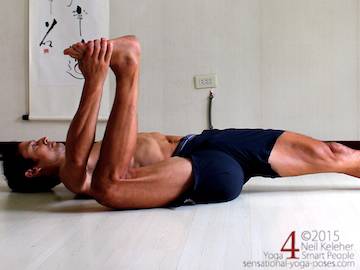
Happy baby pose
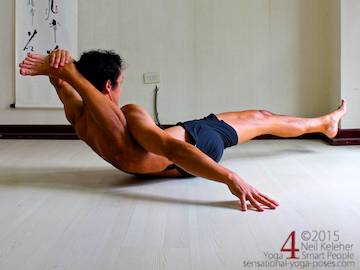
Foot behind the head pose
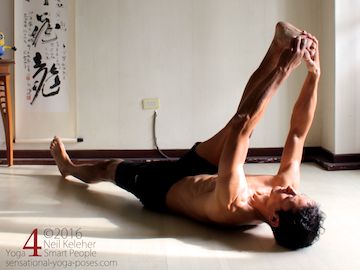
Supine hamstring stretch 1
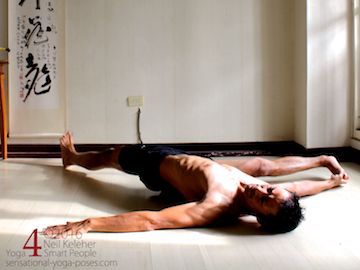
Supine hamstring stretch 2
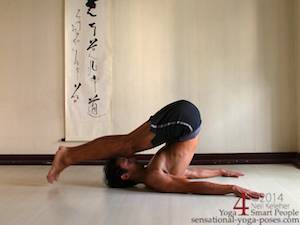
Rolling into plough pose
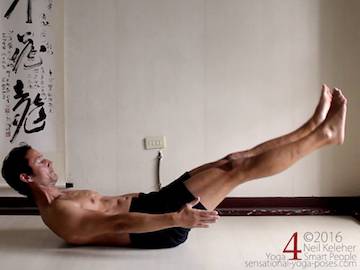
Rolling sit up
Supine yoga poses can be used to strengthen the abs (by bending upwards) as well as the spinal erectors (by bending the spine backwards).
Note that there are both bound and unbound variations of some supine yoga poses.
With unbound supine yoga poses you use muscles intrinsic to the joint. When bound supine yoga poses, you use muscles that aren't necessarily intrinsic to the joint being worked on.
Seated yoga poses are those where one or both buttocks are on the ground and supporting body weight, or poses like table top and reverse plank where you start with the buttocks on the floor. One other exception to this general rule for seated yoga poses is janusirsasana b where you actually place your perineum atop the heel of one foot. Based on this rule of the buttocks being on the floor, some kneeling poses could also be considered as seated poses.

Bound Angle
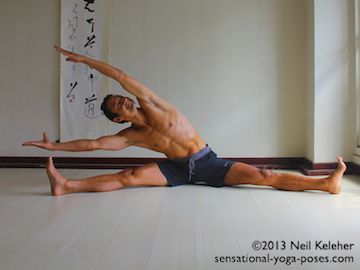
Wide leg side bend
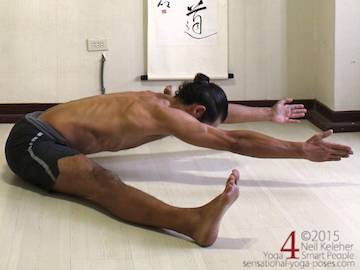
Wide leg forward bend
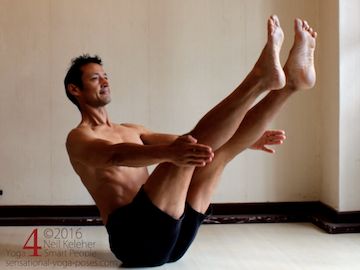
Boat pose

Table top
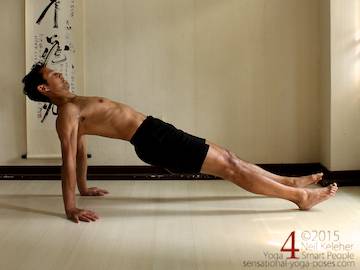
Reverse plank
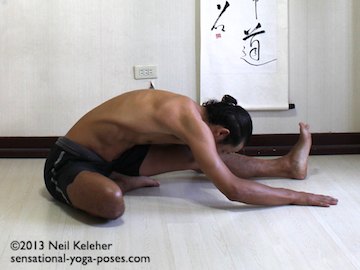
Janu sirsasana A
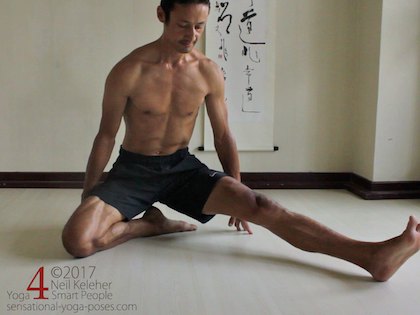
Janu sirsasana B
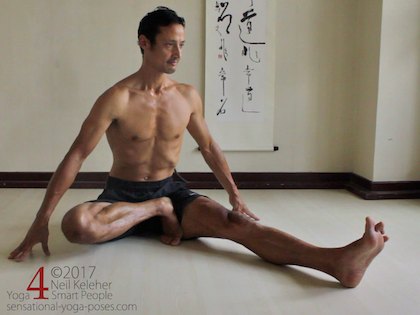
Janu sirsasana C
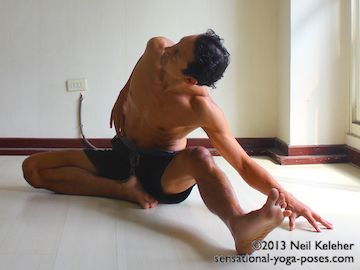
Janu sirsasana Side bend
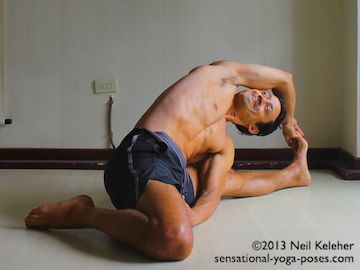
Half hero side bend
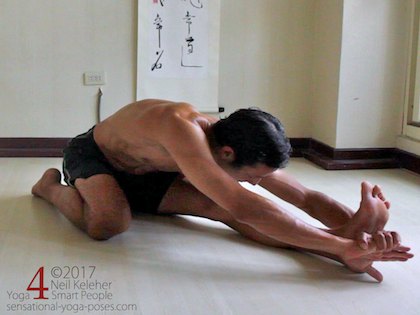
Half hero forward bend
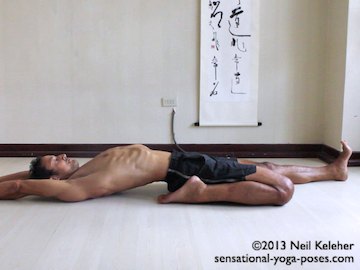
Half hero backbend

Marichyasana E

Easy Marichyasana B

Marichyasana A
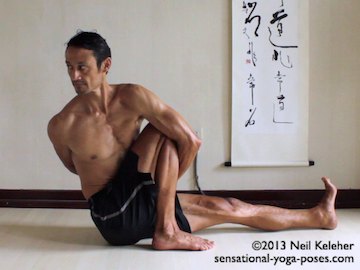
Marichyasana C

Ardha matsyendrasana
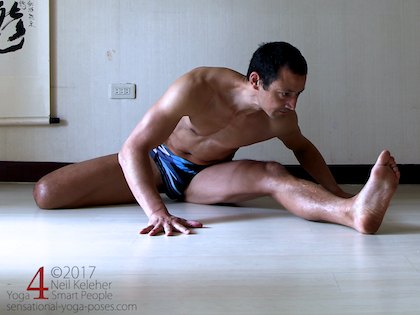
Hurdler's stretch
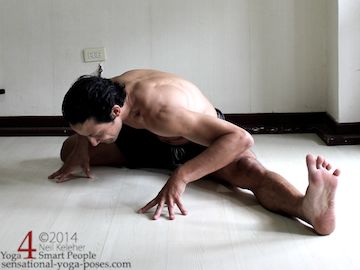
Hurdlers stretch variant (frog pose)
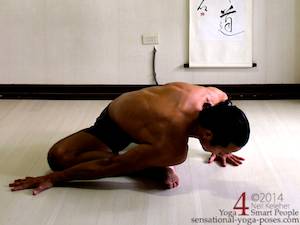
Intense pigeon
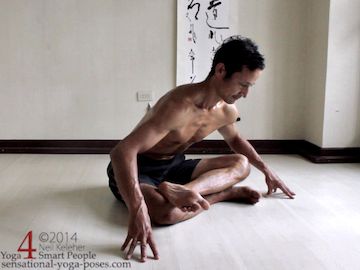
Square pigeon
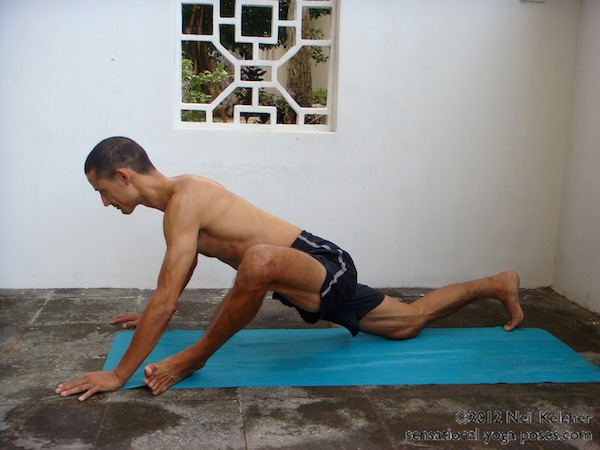
Lunge variant as lotus prep

Half bound lotus

Marichyasana B

Bharad vajasana

Reclining hero
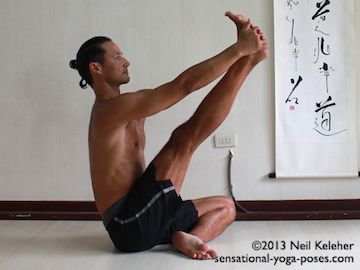
Compass prep/heron variant

Compass pose
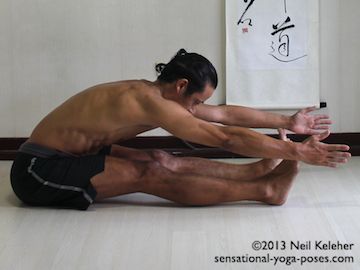
Forward bend
The general complement to seated yoga poses is standing yoga poses. Standing yoga poses can tend to be used to strengthen the legs. In addition, if flexibility is limited, standing poses can be easier.
Standing Yoga Poses tend to be grouped according to whether the reference leg is turned out relative to the pelvis or facing forwards. They could also be grouped according to whether one or both knees is bent or straight. Bent knee poses tend to used to strengthen the thighs. That being said, straight knee standing poses can also be used to strengthen your legs if you make an effort to activate your leg muscles.
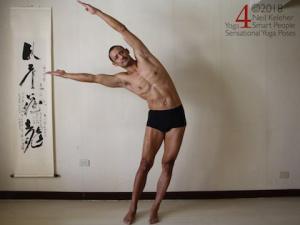
Standing side bend

Half moon
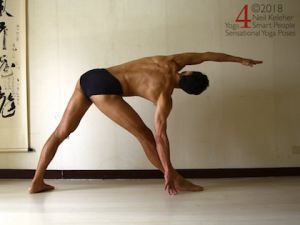
Triangle Pose
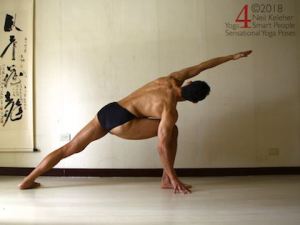
Side angle pose
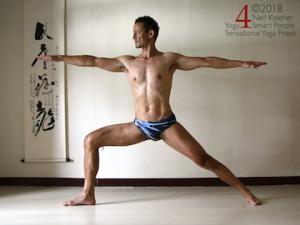
Warrior 2
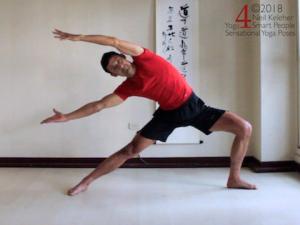
Dancing warrior
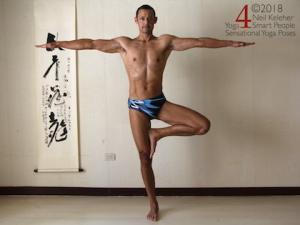
Tree pose
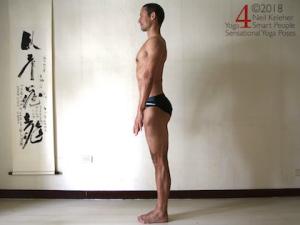
Mountain pose
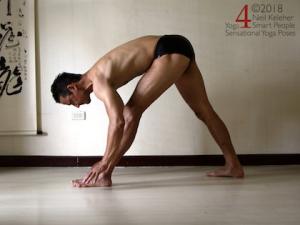
Pyramid pose
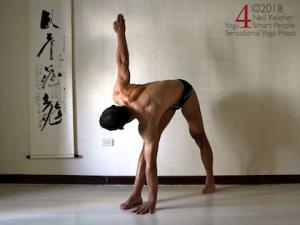
Revolving triangle pose
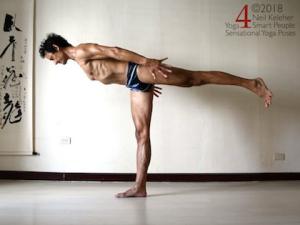
Warrior 3
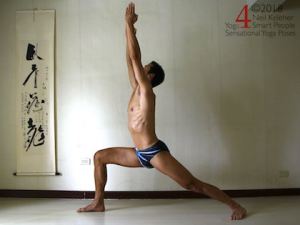
Warrior 1
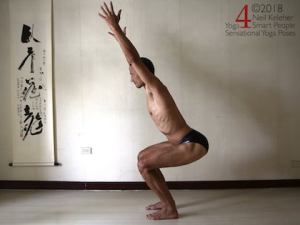
Chair pose (utkatasana)

Eagle pose
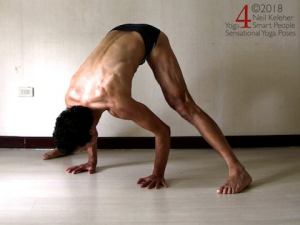
Wide leg standing forward bend
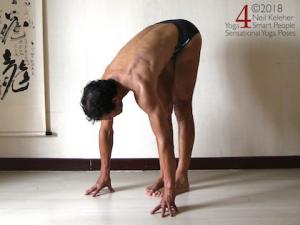
Standing forward bend
Another possible sub-division of standing yoga poses is poses where you stand on one leg.
For a selection of standing yoga poses for dealing with low back pain check out standing exercises for low back pain.
For more standing poses, whether standing on one leg, lateral standing poses or longitudinal standing poses, scroll sideways through the relevant list below.
Ashtanga yoga is made up of different series of yoga poses. The Ashtanga yoga page has links to descriptions of most of the poses in this series of poses.
How do you learn yoga poses from a first principles approach? By learning to feel and control isolated parts of your body.
To access all of my courses, including the courses listed below, become a member. You can cancel at any time.
Links to poses sorted alphabetically by name are included in the alphabetical yoga poses page.
Published: 2015 08 25
Updated: 2021 02 24
